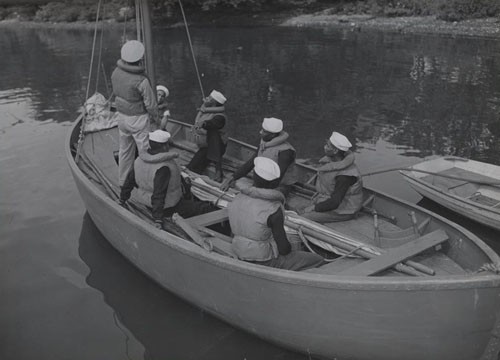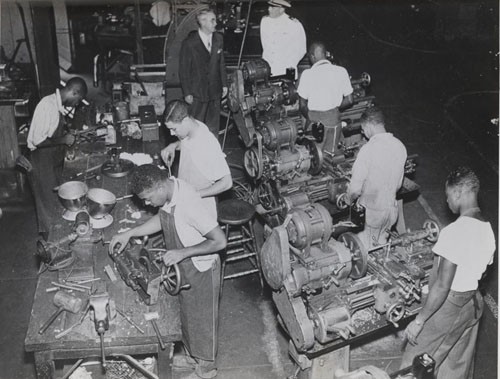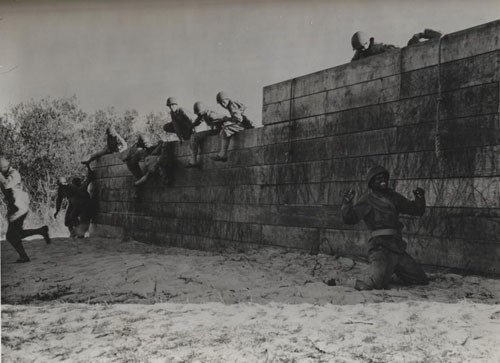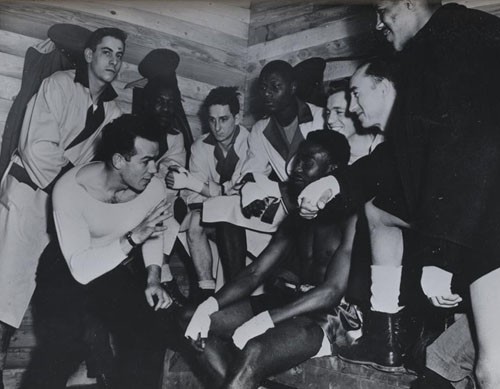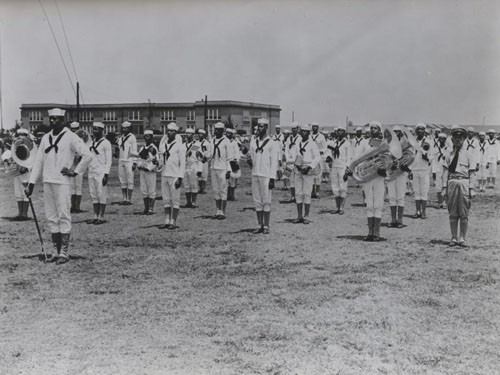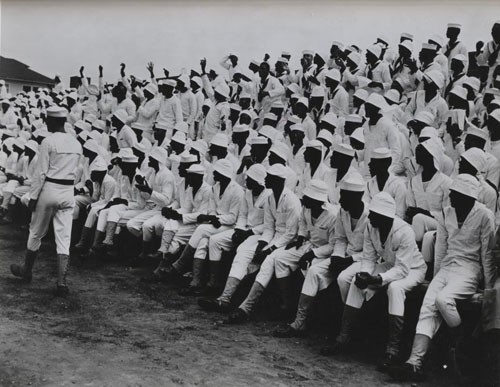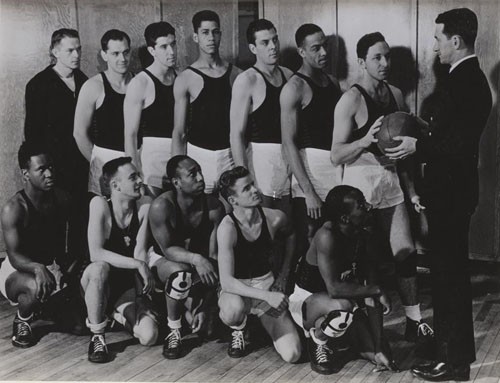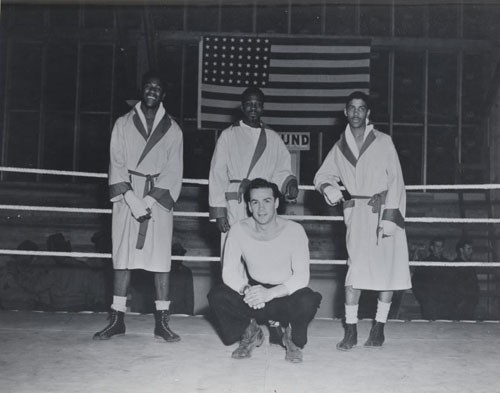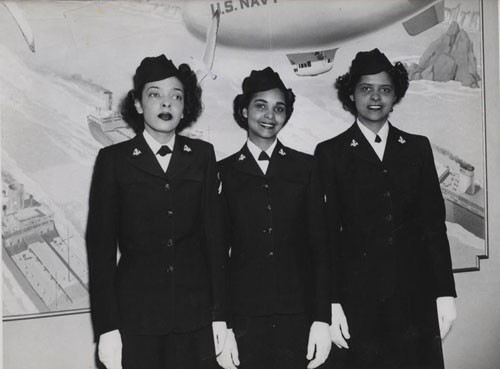Historical Section. Bureau of Naval Personnel. "The Negro in the Navy." (Washington, DC: 1947). [This manuscript, identified as United States Naval Administrative History of World War II #84, is located in the Navy Department Library's Rare Book Room.]

The Navy Department Library
The Negro in the Navy
United States Naval Administrative History of World War II #84
The Negro in the Navy
First Draft Narrative
Prepared by the Historical Section
Bureau of Naval Personnel
1947
Table of Contents
| Page | ||
| Part I | ||
| The Negro in the Navy in World War II | 1 | |
| Sources | 100 | |
| Appendix: List of Documents | 103 | |
| Part 2 | ||
| Photographic Appendix * | ||
* Photographs have been incorporated in the narrative.
No photographs in online project.
THE NEGRO IN THE NAVY
| Page | |||
| I | The Basic Decision | 1 | |
| a. | Before 1941 | 1 | |
| b. | The Decision | 3 | |
| c. | Selective Service: An expanded program. | 9 | |
| d. | Negroes in the Women's Reserve | 15 | |
| II | Special Provisions for Administration | 18 | |
| a. | In the Bureau | 18 | |
| b. | Outside the Bureau | 22 | |
| III | Distribution | 27 | |
| a. | Theories governing distribution. | 27 | |
| b. | Negro competence | 28 | |
| 1. Scores for all recruits | 28 | ||
| 2. Petty officers | 35 | ||
| c. | "Sea Duty" for Negroes | 40 | |
| 1. The Fleet | 40 | ||
| 2. Naval Districts | 45 | ||
| 3. Bases outside the Continental United States | 46 | ||
| 4. The Commissary Branch | 49 | ||
| d. | Shore Duty in the United States | 51 | |
| 1. Balance in distribution | 51 | ||
| 2. Proper use of training | 53 | ||
| 3. Use only in military billets | 53 | ||
| IV | Producing the men | 54 | |
| a. | Procurement | 54 | |
| b. | Training | 56 | |
| 1. Segregation | 56 | ||
| 2. Scope | 59 | ||
| V | On the Job | 64 | |
| a. | Opportunities for skill | 65 | |
| b. | Living conditions and recreation | 70 | |
| c. | Discipline: In general | 73 | |
| d. | Discipline: "Incidents" | 75 | |
| 1. NAD, St. Juliens Creek, Virginia | 75 | ||
| 2. The 80th Construction Battalion | 77 | ||
| 3. Shoemaker, California | 79 | ||
| VI | An Established Program: 1944-1945 | 81 | |
| a. | Organization | 81 | |
| b. | Officers | 83 | |
| c. | Enlisted Procurement | 85 | |
| d. | Enlisted Training | 88 | |
| e. | Enlisted Distribution | 90 | |
| f. | On the Job | 94 | |
| g. | Women's Reserve | 98 | |
I. THE BASIC DECISION
Before 1941
There have been Negroes in the United States Navy since the early years of the Republic, but their numbers have always been small. Camp Robert Smalls, the first Negro recruit camp at the Great Lakes training station in World War II, was named for a Negro who rendered distinguished service to the Federal Navy in the Civil War.
Older Navy men today recall the service of Negroes aboard the larger combatant vessels from the turn of the century through the first World War. They served not only in the messman branch, but also held various skilled ratings as artificers. There is some confusion in the evidence as to whether in this period Negroes were enlisted for general service as well as for the messman branch, or only for the latter. Testimony of men who knew the Navy through those years is at variance; some enlistment records have been seen which indicate direct enlistment for general service, but these may always have been departures from a general rule.
In any case, when the size of the Navy was curtailed in consequence of the disarmament movement following World War I, enlistment of Negroes seems to have been discontinued by BuNav. Recruiting of Negroes as messmen may have been kept open formally, but at least in practice only Filipinos were recruited for this branch from about 1919-1922 until December, 1932. About December 1932, active recruiting of Negroes for the messman branch began and this was the only branch in which Negroes could enlist until recruiting for general service was opened to them as of June 1, 1942. When World War II opened there were on active duty in the Navy, in other than the messman branch, six rated Negroes of the regular Navy, 23 rated men who had returned from retirement to service in the regular Navy and 14 rated men of the Fleet Reserve.
--1--
All of these, presumably, were men who had been serving at the time when the Navy was cut after the first World War; several of them were Chief Petty Officers.
--2--
The Decision
The Selective Service and Training Act of 1940, provided in the preamble that:
(b) The Congress further declares that in a free society the obligations and privileges of military training and service should be shared generally in accordance with a fair and just system of selective compulsory military training and service.
The third proviso of Section 3(a) gave practical application to this declared policy:
...any person, regardless of race or color, between the ages of eighteen and forty- five, shall be afforded an opportunity to volunteer for induction into the land and naval forces of the United States for the training and service prescribed in subsection (b)...
And the first proviso of Section 4(a) stated the obligation of the Services towards all men taken into service:
... in the selection and training of men under this Act, and in the interpretation and execution of the provisions of this Act, there shall be no discrimination against any person on account of race or color.
July 2, 1941, SecNav created a committee, consisting of a Captain and Commander in the Navy, a Colonel in the Marine Corps, and a Special Assistant to Assistant SecNav, "for the purpose of investigating and reporting to SecNav the extent to which (sic) the enlisted personnel of the Navy and Marine Corps is representative of all United States Citizens, and in case there should be any evidence of discrimination because of race, creed, color or national origin, to suggest corrections." Subsequently, "by oral instructions," the committee decided to limit its inquiry "to the existing relationship between the United States Navy, United States Marine Corps and the Negro race."
This committee held three meetings for discussion of the issues under investigation. It reported that prior to 1922 Negroes were recruited for
--3--
general service, that experience showed that this open recruiting yielded only 2.1 percent of Negroes in the Navy, and that few of these qualified for advancement except for ratings where little or no military command must be exercised. There was no report, however, of the extent to which Negro recruitment was pushed or the degree to which there was planning for integration of Negroes into the Service.
A majority of the committee felt that
...the enlistment of Negroes (other than as mess attendants) leads to disruptive and undermining conditions.
and reported to SecNav on December 24, 1941 its conclusion that
Within the limitations of the characteristics of members of certain races, the enlisted personnel of the naval establishment is representative of all the citizens of the United States. Therefore, no corrective measures are necessary.
A dissenting opinion, filed December 31, 1941, was expressed by the Special Assistant to Assistant SecNav. He believed that it should be practically possible to find limited service billets for Negroes, and that the damage done to national morale and harmony by denying them a proportional part in the war effort outweighed what added attention must be given such a program. He thought that
...a limited number of qualified Negroes could be enlisted for duty on some types of patrol or other small vessel assigned to a particular yard or station.
An experiment of this sort, he felt,
...might prove to be of considerable value in case the Navy is later directed to accept enlistment from the Selective Service Rolls.
Pearl Harbor provided the impetus for the next development. December 9, 194l, the National Association for the Advancement of Colored People wired SecNav, asking whether, in view of the intensive recruiting campaign then under way, the Navy would accept colored recruits for other than the messman's branch. BuNav replied that there had been no change in policy and that none was contemplated.
--4--
The NAACP wrote the President in protest of this decision, December 17, 1941. The President referred the protest "for reply" to the chairman of the Executive-created Fair Employment Practices Committee. On December 31, 1941, the chairman informed the President that he had already conferred with the Navy, at the latter's request, on the NAACP telegram of December 9. He advised the President, for himself and his committee, that even following a segregation policy the Navy ought to be able to use Negroes in the Caribbean or on harbor craft. He pointed out, however, that he had discussed the Negro question with the Navy only at its request, that under its Executive Order the FEPC had no jurisdiction of race questions in the armed services, that he could thus reply to the NAACP only on a personal basis along the lines indicated. He suggested, therefore, that the President might wish to consider the matter further.
January 9, 1942, the President referred this letter to SecNav, requesting consideration, and commenting,
I think that with all the Navy activities, BuNav might invent something that colored enlistees could do in addition to the rating of messman.
January 16, 1942 SecNav asked the General Board to submit a plan for taking 5000 Negroes for billets other than in the messman branch, requesting further that the Board state their ideas as to the type of duty, assignments, etc., "which will permit the Navy to best utilize the services of these men." The General Board reported on February 3, 1942. Analyzing the complements of various types of ships, the Board noted that there were few non-rated billets on patrol vessels, and that there were then no Negro officers and few Negro petty officers to fill the other posts. Mingling Negroes with whites in the relatively large number of non-rated billets on larger ships would inevitably promote race friction and lowered efficiency, the Board held.
--5--
The General Board report stated that if restriction of Negroes to the messman branch was discrimination
It is but part and parcel of similar discrimination throughout the United States, not only against the Negro, but in the Pacific States and in Hawaii against citizens of Asiatic descent.
Board went on:
The reasons for discrimination in the United States are rather generally that: (a) the white man will not accept the negro in a position of authority over him; (b) the white man considers that he is of superior race and will not admit the negro as an equal; and (c) the white race refuses to admit the negro to intimate family relationships leading to marriage. These concepts may not be truly democratic, but it is doubtful if the most ardent lovers of democracy will dispute them, particularly in regard to inter-marriage.
The General Board noted that Negroes were permitted some participation in combat, since messmen were given stations during battle. In summary, the Board recommended that
Members of the colored race be accepted for enlistment only in the messman branch
but that if this proved not feasible, they be enlisted for general service.
On February 5, 1942, SecNav transmitted the General Board's report to the President, remarking that
The only special service that I can think of where segregation could be possible would be in the Marine Corps.
The President replied in a memorandum to SecNav stating that he did not believe the only choice lay between messman duty for Negroes and their acceptance into all duties in the Naval service. He felt that
...to go the whole way at one fell swoop would seriously impair the general average efficiency of the Navy.
Nevertheless he believed that there were some jobs other than messman to which Negroes could be properly assigned. He asked that the recommendations of the General Board be returned to that Board "for further study and report."
--6--
On February 14, 1942, SecNav asked the General Board to reconsider the question in the light of the President's comments. Accordingly the General Board on February 18, 1942, asked BuNav to furnish a list of stations or assignments for Negroes in other than the messman branch "and wherever the assignment of these men would not 'inject into the whole personnel of the Navy the race question.'"
The General Board commented:
It is unwise and inadvisable to repeat or further emphasize the undesirability of the recruitment of men of the colored race.
Quoting this last comment, BuNav on February 20 asked CNO and BuAer for recommendations.
On February 25, CNO replied, "that men of the colored race, other than those for the messman branch, be not assigned to ships or shore stations."
If, however, men of the colored race are to be enlisted in the Navy in ratings other than in the messman branch, CNO recommends their enlistment in the Reserve, and their assignment to (1) Construction Battalions under the Bureau of Yards and Docks; (2) Shore Stations, for work around docks or general labor such as now performed by enlisted men, or could be so performed in places like Naval Supply Depots, Navy Yards, Ordnance Stations, Training Stations, Experimental Stations. Section Bases, Air Stations, etc., - in general - the Naval Shore Establishment; and (3) Yard Craft. Of the above listed alternatives, the Chief of Naval Operations would prefer recourse to (1) and (2) only. Alternative (3) has been included in case it is necessary to assign billets afloat.
Cominch noted his concurrence.
On March 20, 1942, the General Board, reported to SecNav that "the organization of ... colored units" could be effected with least disadvantage in the following types of activity, if so ordered: service units throughout the naval establishment (including shore activities of the Marine Corps and Coast Guard); yard craft and other small craft employed in Naval District local defense forces; shore based units for other parts of District local defense forces;
--7--
selected Coast Guard cutters and small details for Coast Guard Captains of the Port; construction battalions; composite Marine battalions. Segregation was an essential principle of administration, and hence Negroes could not be used in any general service billets in the Fleet.
The General Board then restated its views:
The General Board fully recognizes, and appreciates the social and economic problems involved, and has striven to reconcile these requirements with what it feels must be paramount in any consideration, namely the maintenance at the highest level of the fighting efficiency of the Navy ... that wide latitude be granted the several administrative authorities as to rate of enlistment, method of recruiting, training and assignment to duty and that progressive experience determine the total number to be enlisted.
SecNav transmitted the second report on March 7. On March 31, 1942 the President expressed his interest in the report but noted disagreement with the statement that
... wide latitude be given the several administrative authorities as to rate of enlistment, method of recruiting, training and. assignment to duty and total number to be enlisted.
This matter, he said, "should be determined by you and by me!" After conference with SecNav the President ordered that the necessary steps be taken to initiate a Negro program along the suggested lines.
Out of this immediate background came the Navy's announcement, April 7, 1942, that beginning June 1, 1942, Negroes might enlist for general service as well as in the messman branch. The first plan set a recruiting quota of 277 per week; it was contemplated that the first year of recruiting would yield a maximum of about 14,000 Negroes for general service.
--8--
Selective Service: an Expanded Program
At the end of 1942 and in the early months of 1943 pressure converged on the Navy from several sources - the Army, the War Manpower Commission and the White House particularly - resulting in a great expansion of the Negro program. On June 30, 1942, there were 5026 Negroes in the regular Navy (almost all of them mess attendants); this figure was about two percent of the total enlisted male personnel of the Navy, and about two and one half percent of the male regulars. As of February 1, 1943, there were 26,909 Negroes in the Navy. Over two-thirds of these were messmen (18,227); 6,662 were General Service; 2,020 were Seabees. This represented about eight percent of the regular male enlisted male personnel, and about two percent, again, of the total enlisted male personnel as of that date.
The Negro program climbed rapidly in numbers. By December 31, 1943 there were 101,573 Negroes on active duty in various rates, 37,981 of whom were Stewards Mates (about 36%). June 30, 1944 saw a total of 142,306, of whom 48,524 were Steward's Mates (about 33%). The figure for December 31, 1944 indicated the leveling off of growth, with a total of 153,199, including 52,994 Steward's Mates (about 34%). As the war reached its climax, on June 30, 1945, the Navy counted on active duty 165,500 colored enlisted personnel. 75,500 of these were Steward's Mates (about 45%). As of June 30, 1945 about 123,000 colored personnel had served or were serving overseas.*
The Joint Chiefs of Staff in the fall of 1942 requested that a study be made of personnel needs of the Services in 1944 and beyond, and also directed
___________
*See Yearbook of Naval Personnel Statistics, 1944, Table 8 ("Negro Ratings: Number of Negroes on Active Duty by Rates," (1943-1944), and table 27 ("Duty Assignments of Negro Enlisted Men Rated and non-Rated Negroes on Board Various Activities, 31 December 1944"). The 1945 figure is from the files of the special programs unit, Planning and Control Activity.
--9--
that consultation be had with the Chairman of the War Manpower Commission to establish a proper balance between manpower resources and requirements. On October 19, 1942, the Chief of Naval Personnel noting that these studies were under way, wrote the Commandants of the Coast Guard and Marine Corps that
It is anticipated that the employment of Negroes will be a matter of discussion in this connection.
Accordingly, he requested their views regarding "the maximum number" of Negroes who might be employed in their respective Services. The Coast Guard replied that it could use 2000 colored men in the Messman Branch, 390 on ships in branches other than the Messmen's and 1610 in miscellaneous general duty. The Marine Corps replied that it had planned to use 1041 in "composite battalions", in the fiscal year 1943 and a like number in 1944. Otherwise, without giving estimates the Commandant believed that
In the event the decision is that the Marine Corps must take Negroes, a small number could be used as (a) Messmen at larger Marine Corps posts within the United States, (b) Labor Battalions. The Primary duties of these battalions will be the unloading of ships in the theatre of operations.
The Commandant expressed the opinion that if the Corps were required to take more Negroes than already planned, increases in its total size would be necessary, since previous estimates of its total personnel needs had been made on the assumption that all men therein would be of the type now being enlisted.
Much broader considerations and conflicts over manpower policy than those involved immediately in the Negro program led, on December 5, 1942, to the President's decision that, except for the existing backlog of applications for enlistment, the Navy must henceforth obtain all of its draft age recruits through the Selective Service system. This new procedure went into full operation by the first week of February, 1943.
--10--
Meanwhile, at meetings on January 20 and 27, 1943, the War Manpower Commission (including representatives of the War and Navy Departments) discussed the induction of Negroes in numbers proportionate to their number in the population. The Commission already had before it a recommendation of its staff that, beginning April 1, 1943, local draft boards be instructed to fill their quotas by taking registrants according to their order numbers without regard to color. Previously, with the Army alone taking colored registrants, separate calls had been issued for whites and Negroes, and local boards passed over Negro registrants in order to fill white calls. The Selective Service System had, in consequence, a backlog of several hundred thousand colored registrants who, according to their order numbers, should have been called to service, but had been passed over. The Commission now asked the Army and Navy representatives to report to it the reactions of the Departments to the proposals to end special calls.
The chairman of the War Manpower Commission wrote SecNav, February 17, 1943 that
The practice of placing separate calls for white and colored registrants is a position which is not tenable, and it is now necessary to begin delivering men in accordance with their order number without regard to race or color.
Negroes formed ten percent of the country's population, but so far were less than six percent of the armed forces, and almost all of these were in the Army, the Chairman continued. The Selective Service Act imposed a ban on racial discrimination, he pointed out, and apart from this there were serious social implications in the existing state of affairs:
The low percentage of Negroes in the Army and in the Navy has resulted in a higher percentage of Negroes in the civilian population. This situation is made more serious because of the geographical concentration of Negroes and because nearly all of the men involved, Negro and white, have been single ... This condition has been the cause of continuous and mounting criticism. It possesses grave
--11--
implications, should the issue be taken into the courts, especially by a white registrant. The probability of this action increases as the single white registrants disappear and husbands and fathers become the current white inductees, while single negro registrants who are physically fit remain uninducted.
After the Navy came under Selective Service, it was the Bureau's expectation that the old quota of about 1200 general service end 1500 messmen could be continued. But in a memorandum of February 22, 1943 to SecNav the President suggested that a check of all present white and colored enlisted jobs in the Navy would show places for further use of colored men, including "shore duty of all kinds, together with the handling of many kinds of yard craft." He emphasized that there would be much criticism, if Negroes were not used ultimately in proportion to their numbers in the population.
On February 26, 1943, the Bureau recommended an increase from the existing total quota of 2700 per month to 5000 in April and 7350 for each of the remaining months of that year; mess attendants were to be increased from 1500 to 2600 per month, 4750 would be trained for general service, and 1000 would go to the SeaBees. On February 26, 1943, SecNav wrote the War Manpower Commission that the Navy, Coast Guard and Marine Corps would absorb up to ten percent of Negroes in their personnel, but that separate white and colored "calls" must be continued for the time being to permit of adjusting the increasing flow of colored men to the expansion of needed facilities. On March 2, the Commission expressed its gratification at the Navy's statement, agreed to temporary continuation of separate calls, and requested figures as to the monthly calls planned by the Navy and its related services.
SecNav's reply to this last request, on March 13, 1943, made clear that the Navy interpreted its obligation to make up to ten percent colored as meaning
--12--
up to ten percent of the total increase of its personnel between February, 1943 and January 1, 1944. The Commission found this inequitable, in a reply, March 23, 1943, requesting the induction of approximately 125,000 Negroes by January 1,1944, in contrast to the Navy's proposed 80,350. The Commission's chairman stated that this figure "will enable us to plan for the initiation of general calls without specification as to the respective number of Negro and White registrants." The Navy finally struck a compromise with the Commission to the extent that it was agreed that Negroes would be taken at the rate of about 12,000 per month for the rest of 1943 for a total of 107,650 by December 31, 1943, with enough expansion of the early months' quotas in 1944 to make up the 125,000 figure demanded by the Commission.
The President had indicated that he desired a fairly wide dispersion of the Negroes throughout the shore establishment, including their assignment to yard craft and other small vessels. On February 25, 1943, close on the heels of the President's order that a proportionate number of colored personnel be used, SecNav submitted an outline plan prepared by the Bureau:
(a) Increase the all-colored construction battalions from two to five; (b) Provide for 24 new construction battalions, all non-rated personnel to be colored; (c) Increase the numbers of colored crews in the harbor craft and local defense forces; (d) Create service companies at all ports of embarkation; (e) Increase the number of colored cooks and bakers in the commissary branch for shore establishments within the United States; (f) Increase the percentage of colored personnel at section bases, ammunition depots, net depots and naval air stations on this continent.
This outline was approved. SecNav on April 14, 1943, sent the President a further outline of policy:
Salient features of the Navy program are: (a) There will be no mixing of crews on large combatant ships other than for personnel
--13--
of the Stewards Mates branch. (b) No Negro personnel will be assigned initially to the Hospital Corps. (c) Negro personnel will be used to fill complements of all local defense and district craft. (d) Negro personnel assigned to the SeaBees will be for special all-Negro stevedore battalions and, in addition, be assigned to construction battalions with white personnel. (e) Negroes will be used at all shore stations, both inside and outside the continental limits of the United States, in varying percentages, averaging about 50% of the non-rated personnel at these stations.
This in fact stated some major features of the program as it grew for two years. Some points, as the use of Negroes at bases outside as well as within the United States, did not begin to develop fully until the end of that period. The President likewise approved the April 14 memorandum.
By the end of the second year of the program, it was clear that the ultimate total of Negroes in the Navy of World War II would be nearer five than ten percent. The two principal factors in the situation were (1) that the Navy would not use Negroes in the Fleet, except in the Stewards Branch and (2) that a half to two thirds of the colored men were qualified only for unskilled work, of which the Navy, by the nature of its technology, had not enough to go around. By the spring of 1944, however, the Bureau was prepared to ask the War Manpower Commission for a formal cut in the allocation of colored men to the Navy, to reflect the realities of the situation.
--14--
Negroes in the Women's Reserve
When the original legislation for the Reserve was being considered in hearings before the Senate Naval Affairs Committee, May 19, 1942, Negro women's organizations urged the inclusion in the bill of a stipulation that
in the selection, appointment, training and classification of women under this act and in the interpretation and execution of the provisions of this Act, no distinction shall be made on the ground of race or color.
It was noted that a similar provision had been proposed and rejected in connection with the legislation creating the Women's Auxiliary Army Corps. The proposal was received by the committee, but nothing further was heard of the suggestion. There was, on the other hand, nothing in the terms of the Women's Reserve legislation as passed to exclude Negro women from the organization.
When recruitment for the Women's Reserve began, in the summer of 1942, several score of requests to enlist were received at the Bureau from Negro women but none were accepted. There is no evidence of White House intervention on the issue. March 9, 1943, a White House memorandum for the President passed on a protest of the Greater New York Federation of Churches against exclusion of Negroes women from the Marine Corps Women's Reserve. The memorandum was returned with an unsigned notation: "Take this up with the Secy of the Navy - Strictly speaking the woman is dead right."
By early 1943, however, there was enough pressure from both white and Negro organizations to require an examination of the issue. Thus in a letter of December 30, 1942, to the Public Affairs Committee of the National Board of the YWCA the Chief of Bureau explained that
At this time the Navy does not have any substantial body of Negro men available or qualified for general service at sea. There is no occasion to replace Negro enlisted Personnel by Negro women enlisted in the Women's Reserve.
--15--
In the spring of 1943 the office of the Women's Reserve, pressed for serious consideration of the recruiting of Negro women. A Women's Reserve officer was added to Planning and Control's special programs unit for the purpose of surveying opportunities for employing colored women and laying basic plans. On May 25, 1943, various memoranda sketching plans were submitted to the Chief of Bureau.
In these memoranda the suggestion was made that Negro women be recruited. Procurement would be through the ONOP's, as for white women, with assistance rendered by the Recruiting organization. Standards of selection would be the same as for whites and a top figure of 5000 would be set for the first year, roughly approximately a 10% rule. Training would be segregated and Negro colleges might be used. Instruction would be the same as for whites, and would be conducted, by Specialists (T), as soon as they could be obtained. Twenty-five colored officer candidates would be selected to begin with, to be sent to the Women's Reserve officers indoctrination school at Smith College, thereafter to perform administrative duties at the colored training schools; other officer candidates might later be selected as the need proved itself. At the outset the rates open include Yeoman, Storekeeper, Ship's Cook, Baker, Hospital Apprentice, and Specialists (S), (T), and (U). The colored Waves would be detailed in units suitable for separate housing, and to activities where Negro seamen were detailed and to the larger Naval Air Stations. Messes as well as quarters would be segregated on the job: the memoranda did not specify regarding segregation at work.
--16--
The Director of the Women's Reserve accepted these plans as a basis for discussion, but she was deeply concerned lest the great bulk of the Negroes brought in under any program likely to be adopted would be detailed to the type of work which Negro opinion resented as menial. The first annual report of the Women's Reserve stated:
The Director (of the Women's Reserve) is prepared to recommend admission without discrimination, but is well aware of the practical difficulty involved in implementing such a recommendation.
In September, 1943, a conference of District Directors of the Women's Reserve, recommended:
that the inclusion of Negro women be deferred as long as possible, and that when the program becomes effective, the plan be as similar to that for men as possible.
--17--
II. SPECIAL PROVISIONS FOR ADMINISTRATION
In the Bureau
Special provision for handling the problem of Negroes in the Navy began with a directive from AsstSecNav to the Chief of the Bureau of Navigation and the Director of the Office of Public Relations, January 16, 1942, instructing that all incoming questions regarding the position of Negroes in the Navy be referred to him. The directive stated that this step was taken because of the obviously delicate nature of the issues.
Noting that a critical point had been passed with the announcement of the decision to enlist Negroes for general service, AsstSecNav cancelled his former directive, by letter of May 20, 1942. On May 26, 1942, a memorandum from the assistant Chief of Bureau to the heads of all divisions of BuPers designated a Lieutenant Commander of the Naval Reserve to coordinate all activities in connection with the enlisting and training of Negroes in the Navy and to handle all correspondence regarding the subject. This Lieutenant Commander shortly thereafter also assumed the job of Bureau Public Relations Officer, and consequently was able to devote only a part of his time to a concern with Negro activities. For nearly a year the initiative for broad planning of the Negro program lay in his hands.
In the summer of 1942 the Bureau was under reorganization, according to the blueprints of a firm of management advisors. The blueprints included a Planning and Control Division, one of whose primary functions was to overcome the inertia with which any large organization meets a new and strange problem. The foresight of the management advisors went further, to the point of visualizing in the Planning and Control Division a "special programs" unit. Its job would be to take the initiative in comprehensive planning for a new program and to coordinate the varied activities of the operating divisions as they came to bear on the program.
--18--
The need was as the management engineers foresaw, and the results of their planning were good, so far as the blueprint was implemented. But progress was unfortunately slow and the means devoted to the problem never adequate.
Setting up Planning and Control took a long time. The Negro problem was one of the knottier puzzles of an expanding Navy, but it was a minor problem in the total picture. It is not surprising, therefore, that the establishment of a special unit was not pressed and that the unit was not functioning until the fall of 1943.
In June, 1943, following SecNav's intimation of concern over inadequate provision for Negro recreation at various activities, Planning and Control caused a conference of District Welfare-Recreation Officers to be called. These men brought up such a variety of problems as to point up the need for a focus of advice and assistance in the Bureau.
In a memorandum to the Chief, June 29, 1943, the Director of Planning and Control recommended that "A captain, carefully selected for his sympathetic understanding of the Negro problem as much as his naval experience, should be detailed as Special Assistant to the Chief of Naval Personnel" to administer the Negro program. It was emphasized that this administrator should be given a highly competent staff, some of them assigned to the Operating Divisions of the Bureau, so that his recommended policies and procedures might after approval be carried out "uniformly and in time."
The recommendation was sound in urging that the problem be given the amount of specialized attention which its complexities demanded. The approach taken was open to two objections, however.
First, the suggestion was not that the special unit be a part of Planning and Control, but that it have an independent status somewhat similar to that of the Office of the Women's Reserve. The management advisor to the Chief of Bureau was opposed to separate status for a Negro program. On reconsideration, Planning and Control withdrew this aspect of its recommendation, and steps were taken to order in officers deemed specially qualified to form a unit within the Division.
--19--
A second objection to the memorandum of June 29, 1943, was its concentration upon handling the Negro program in the Bureau. This was a natural emphasis for a period in which the prime issue had been the scale on which Negroes could be taken in and the uses to which they would be put. These were questions which had to be settled at the center. But the time was close when emphasis must shift to the field.
About the end of August, 1943, the recommendation was made that the special unit should consist of not less than one commander, four lieutenant commanders and two lieutenants. The senior officer would be primarily concerned with the overseeing of the whole program from the vantage point of the Bureau. The two lieutenants would be his leg men to keep a firm check on the progress of programs in the day-to-day administration of the operating divisions; at least for a transitional period, the actual administration of the critical job of distribution would be taken over from the Enlisted Division. Each of the lieutenant commanders would ride circuit between the Bureau and one of four areas into which the United States would be divided, according to the distribution of Negro personnel. Their task would be one of continuously interpreting Bureau policy to the field and field problems to the Bureau. They would come to local activities as advisors armed with the best forethought and experience which the Bureau was able to gather for the assistance of the activity CO's whose traditional
--20--
autonomy would not be invaded. At that time the unit consisted of a lieutenant commander and lieutenant reporting to the Control Officer for the Planning and Control Division. Both officers had had about a year's experience in Naval training school for Negroes.
--21--
Outside the Bureau
The peculiar difficulties of the Negro program called for some adjustments in relations between the Bureau and the activities and in personnel administration in the field. Following sound principles, these efforts took the form of tightened central control over the application of one crucial policy and attempts to strengthen local personnel and then leave them to work out their own problems of adjustment.
The issue of central importance was that of distribution (discussed in detail in Part III.) For the kinds of billets to which Negroes would be assigned would determine the numbers readily to be taken, types of training and the state of morale. Control of distribution was, therefore, kept carefully in the Bureau, and within the Bureau it was watched closely by the special unit of Planning and Control. The plan for an expanded special unit had contemplated that, until the application of basic policies was firmly set, the actual detailing would be done by Planning and Control. Though the plan was not adopted and the personnel available did not permit doing this, Planning and Control kept in close touch with the Enlisted Division on all detailing policy. Planning and Control settled two important issues first, that distribution should follow the general lines of surveys made in the field by its representatives; and second, that special pains were to be taken that northern Negroes be not detailed to the South, if possible. Applied to the field, those Bureau policies meant that Negro drafts were not sent to the Districts for further distribution according to the discretion of the Commandant, as in the case of whites. By conference between Planning and Control representatives and the CO's and personnel officers in the various commands and activities, definite figures were reached as to the number of Negroes to be included in station complements and the types of jobs they would fill. Negroes were detailed accordingly, and
--22--
the Districts were under instructions not to change the detail without consultation with the Bureau. This was fortified by the injunction to use the men in the ratings for which they had been trained. As Bureau representatives travelled among the activities to the extent that their limited numbers permitted, they kept constant check on compliance with these directives. Similar Bureau control of distribution was exercised regarding the Women's Reserve, because like need was felt to control the execution of policy in a new field.
In the period in which the general Negro recruiting campaign was on, between June 1, 1942 and February, 1943, the Bureau left promotional activities almost entirely up to the Negro recruiting officers who had been carefully selected. This policy was intended to facilitate the personal contact approach that was the staple of the recruiting stations.
The lesson was early learned that what must count in initial selection was imagination, firmness and capacity to deal with people, rather than any specialized background of "knowing" Negroes. An officer with a record of highly successfully training of Negro SeaBees warned against this theory:
We no longer follow the precept that southern officers exclusively should be selected for colored battalions. A man may be from the north, south, east or west. If his attitude is to do the best possible job he knows how, regardless of what the color of his personnel is, that is the man we want as an officer for our colored SeaBees. We have learned to steer clear of the "I'm from the South - I know how to handle 'em" variety. It follows with reference to white personnel, that deeply accented southern whites are not generally suited for Negro battalions.
The problem then was one of training. In the summer of 1943 the experiment was tried of inviting activities to recommend officers to be sent to Great Lakes or to Hampton Institute for a few weeks indoctrination in dealing with Negro
--23--
recruits. The experiment was not a success. The activities tended to employ this as a device for ridding themselves of their least desirable officers. The training schools were too understaffed and too busy to be able to do much for those who came for the indoctrination, and they were little else than passive observers. Taking charge of a Negro company was obviously the way to learn how to handle the men, but, equally obvious, the training schools could not afford the inefficiency that would result from handing their trainees over from one unskilled officer to another. Consideration was given to the plan of asking for volunteers at the white officers' indoctrination schools, and detailing enough additional men to make up a quota of 15 per month to be sent on for further indoctrination in commanding Negro units. But experience at the schools pointed to a more fundamental solution. In the acute need for capable men to be company commanders, Great Lakes had obtained a number of white Specialists (A). When it became a most difficult problem to find competent leadership for "base companies" of Negroes to be sent to the Pacific areas, a number of white Specialists (A) were obtained and the result was promising. Some of these had been commanders at Great Lakes or Hampton, and those who had not had this experience in handling colored units were sent to those schools for indoctrination before assignment to base companies. Hence, in January 1944, the Bureau recommended that up to 30 white Specialists (A) with satisfactory records as Great Lakes Negro recruit company commanders be commissioned, for assignment to units needing an officer experienced in handling Negro personnel. The Specialist (A) group promised to be a fine reservoir of talent for the program; its members had been initially chosen for their capacity to act as morale officers and represented a selective group in terms of education, maturity and experience in dealing with people (many were men whose profession was public recreation work.) The tie-up with the Specialist (A) program should have been made earlier.
--24--
The Bureau had acted too slowly in obtaining qualified white officers to lead colored units. The impetus to do something came primarily from the problem of officering Negro units being sent out of the country. But the Board of Investigation which inquired into a near riot at the St. Juliens Creek ammunition depot in May, 1943 found that inept handling by the white officers in charge as the proximate cause of that dangerous situation at a station in the continental United States. The Board pointedly recommended that
Assignment of officer personnel to organizations should be made upon qualifications for leadership and for the specific type of employment contemplated for the organization.
The provision of additional or special housing, messing or recreational facilities was one highly practical problem for most activities which received Negro sailors. Though the general outlines were much alike everywhere, the actual achievement of a satisfactory situation presented questions peculiar to each station. The Bureau therefore showed marked liberality in approving station requests. This was especially true regarding the provision of recreational facilities. This policy is notable as an instance in which the very special character of a problem led the Bureau to decentralize rather than concentrate the control of decisions. The Bureau did assist the local activities to the extent that its representatives were able to advise and pass on the experience of other stations in the course of their survey visits.
Recognizing that the Women's Reserve presented many novel problems to the activities, the Bureau issued several circular letters declaring general policies concerning the integration of the women into the establishment. No such policy letters were issued regarding the Negroes; reliance was placed on conferences with key officers in the field. Some of this could be done, though slowly, as the members of Planning and Control's special unit made their survey trips starting in the late summer of 1943. In October, 1943, a fifth Naval District
--25--
conference was attended by fifty or more officers concerned with Negro personnel, at which policy was discussed and experience passed on. This device was believed sufficiently successful; similar conferences were subsequently conducted in other areas. In the summer and fall of 1943 policy and plans were discussed at the Bureau with the personnel officers of Naval Districts concerned, who were invited in twos and threes. That it was done by conference had advantages in persuasion and flexibility over the issuance of policy letters.
Admittedly, there were difficulties in the way of a general policy for the field. In the first place, generalization itself was extremely difficult. An attempt was made to draft a statement on the key issue of segregation, but it was given up because so many qualifications had to be introduced that the document lost any helpful definiteness which it might have had.
Objections to the issuance of general policy statements on the Negro program could have been met by generalizing only to the extent that which was clearly practical and then marking out for the field the areas in which the activities must work out reasonable solutions, with Bureau support guaranteed. Even where no generalized direction could be issued, a number of variant cases could be cited to the field to illustrate the lines of Bureau thinking and to pass on experience gained in the best stations.
--26--
III. DISTRIBUTION
Once the fundamental decision had been made and enforced, that a substantial number of Negroes should be enlisted for general service, the issue to which all other questions of administration were corollary was the definition of what jobs they should do in the Navy. The types of jobs open would obviously shape the training program. They would affect the enlistment decisions of men outside the draft and the preference expressed at induction centers by selectees for Army or Navy service.
--27--
Negro Competence
Though whites and Negroes of comparable background made comparable records, the different opportunities of the races naturally were reflected in over-all comparisons of intelligence ratings, aptitudes and learning. Thus a Great Lakes survey in the fall of 1943, when the expanded program was in full swing, showed average General Classification test scores 22.2 for Negroes and 47.8 for whites with 73% of the Negroes tested scoring below 30. The following table, compiled by the educational Planning Officer, NTS Great Lakes, summarizes overall group performances in tests in the summer of 1943:
| Scores for All Recruits | ||||||
| GCT | Read. | Math. | Mech. Apt. | Mech. Knowledge | Elec. Knowledge | |
| White: | 48 | 44 | 44 | 47 | 48 | 49 |
| Negro: | 34 | 34 | 30 | 35 | 26 | 37 |
| Scores for School Selectees | ||||||
| White: | 57 | 53 | 51 | 53 | 50 | 51 |
| Negro(1): | 48 | 53 | 39 | 41 | 35 | 42 |
| Negro(2) | 53* | 48 | 43 | 44 | 37 | 47 |
| *Excluding Cooks and Bakers | ||||||
These comparisons of the racial groups taken as wholes were reflected in Service school quotas. At the time of the tests summarized in the above table, about 35% of the whites going through recruit training at Great Lakes were selected for service school training; about 31% of the Negroes. The Negro 31%, however, included 500 men per month entering the Cooks and Bakers school, which had the lowest requirements of the Class A schools. As of early September, 1943, about 40% of all enlisted personnel graduated from recruit training were sent to Class A schools; about 33.14% of Negro recruits went to Class A schools. In April, 1944, the Class A school quota was set at a new low point of about 23%. Behind the tendency for this percentage to decline were causes somewhat more
--28--
complex than can be fairly summed up in the simple statement that there were not enough qualified colored personnel available to fill the schools to higher levels. This was in large part true. It was also true, though for reasons no one could explain, that the quality of the particular Negro input under Selective Service dropped in the months before April, 1944. School quotas were cut in some cases because there were no more billets for the ratings within the Navy's general framework of the use of the colored men. The classification unit at Great Lakes estimated that 25% of Negro recruit school graduates were qualified for Class A school training; a comparable estimate for whites was 40-50%. On the whole, the experience was that every qualified Negro could go to a Service School, but there sometimes were not enough to fill the quotas.
Two factors remain to make a balanced picture of the quality of the Navy's Negroes. First, the Navy did not get as good quality as it might have. This is suggested by the relative concentration of illiterates (here defined as individuals having less than four year's of schooling) in the service and in the general Negro population. While Negro illiterates reporting at Great Lakes 1943 amounted to 30% of colored recruits reporting there, the percent of male Negro illiterates between the ages of eighteen and forty-four was estimated for the country as a whole in 1940 (World Almanac, 1943) as 23.4; corresponding estimates for age groups 18-20 and 21-24 were respectively 17.6 and 20.6.
The second factor which must be weighed in appraising the quality of the Navy's Negroes is that their handicaps were of a sort which experience proved could be overcome to a degree, even in the limited training time available. They did not make as good a showing at learning as did the whites; Negro test grades at Great Lakes at best tended to run about 10 points below whites. Morale is an important factor in learning, however, and the typical Negro recruit at Great Lakes took his Navy training as an opportunity for advancement. A report of the Educational Planning Officer at Great Lakes noted this:
--29--
The achievement of the Negroes is consistently somewhat lower then that of the white students. The background experience conducive to efficient learning is markedly lower for Negroes than for whites. The Negro students make up for their poorer background to some extent through their greater earnestness and effort.
There was testimony to this earnestness in the fact that thousands of men worked hard at the remedial school in the three R's at Great Lakes, two hours a night five nights a week and two hours on their free Saturday afternoons, all simultaneously carrying on the regular drill schedule. All instruction was by Negro college men who volunteered their time. At the end of the six weeks course, 72% of the illiterate men who took it were able to pass fourth grade examinations. In service schools, Negro test scores were consistently lower than whites, under equally competent instructors and in smaller classes. Scores were lower in one test machinists' mates class, though twice the time was taken to cover the same material given white students. However, Great Lakes instructors were reported by the Educational Planning Officer as in agreement that generally where the Negroes were given longer training, they showed up about as well as whites in shop work, though their poor background held them back in advanced mathematics and theory subjects. Learning continued on the job, and although the Bureau did not conduct any scientifically directed check on rates of progress, field surveys by its representatives as well as various reports from activities generally agreed that the Negroes learned and carried on their duties with greater efficiency than had been anticipated.
In the fall of 1943 the Bureau achieved a reasonably wide distribution of colored personnel among District activities. minimizing the creation of large, segregated groups. The tightening manpower situation and the increasing difficulty in finding billets for the numbers of Negroes inducted under Selective Service tended to reinforce this policy development. This was underlined by the approval
--30--
by the President in May, 1944, of the Bureau's request for approval not to exceed ten percent of any station's complement.
Policy consisted not only in refraining from Negro assignments to certain areas, but also in the care taken to avoid sending northern Negroes to such southern activities as did receive colored personnel. In making up drafts, Great Lakes even sought, where possible, to send men back to the same district in which they were enrolled. A curious converse problem arose. It was felt that experience showed that Negroes had a greater tendency than whites to bring their families to the area where they where stationed. Because of this ComTHREE requested that Negroes who came from New York City be detailed back there, to prevent further pressure on the city's overcrowded Negro districts caused by an influx of new families. The Bureau agreed that the request was reasonable, and noted that it could not be fully carried out:
Of the Negroes inducted into the Navy 65% or more are from Southern states. However, considerably less than 45% of the enlisted personnel in the Continental United States are stationed in Southern Naval Districts.
A difficulty in following the policy as to the South was, that most of the men qualified for ratings were Northerners.
Procurement of Negro Officers
There were two lines of possible development: the admission of Negroes to the V-12, or college program, under which young men were permitted to enlist as apprentice seamen, after passing a competitive examination given throughout the country, and then permitted to attend college, taking a course preparatory to attending officer's indoctrination school; or, the commissioning of men direct from civilian life or from the enlisted ranks. The second, being the shorter route was the principal focus of controversy.
--31--
Shortly after the Negro training school at Hampton Institute was established, a white instructor there suggested informally to the Bureau that it would be beneficial to commission a few Negro members of the Hampton faculty who were instructing the Navy trainees. This suggestion was not accepted. The President's order that, starting in February, 1943 the Navy must take all draft-age men via Selective Service, and that it must take a fair share of Negroes thereunder, first made Negro commissions a real issue in the Bureau. In that month the estimate was made that as a result of these orders there would by December 21, 1943 be perhaps 125,000 Negroes in the Navy, 100,000 of whom would have entered under the Selective Service Act. Not only did that act stipulate that "in the selection and training of men under this Act ... there shall be no discrimination against any person on account of race or color", but the sheer weight of the fact of over 100,000 Negroes with no Negro officers would give added impact to former pressures. A memorandum within the Bureau recommended that plans be made immediately to commission 50 Negroes from civilian life and to scan the enlisted ranks for an additional qualified 25; that these men be sent to indoctrination; and that they be assigned to activities already having large numbers of Negro enlisted men where the issue of social mixture would not be acute, such as the Naval Ammunition Depots. These recommendations were rejected by the Bureau but the problem of the commissioning of Negroes continued to be considered.
On December 2, 1943, the Chief of Bureau recommended to SecNav that the Navy commission 12 line and 10 staff officers, of the Negro race. Two of the line would be destined for instructional posts at Hampton Institute and the other 10 for Great Lakes. They would be designated, after an indoctrination period at Great Lakes from a group of about 20 men to be selected from the enlisted ranks on the school's nominations from their best graduates. Staff officers would be selected direct from civilian life; indoctrinated at Great Lakes and assigned
--32--
to the staffs of the two training schools; there would be two each in the, Chaplains, Dental, Medical, Civil Engineers and Supply Corps, respectively. The Bureau letter noted that the consent of the other Bureaus concerned had been indicated. The Chief of Bureau based his recommendation on the fact that the Navy then had 82,000 Negro enlisted men in all pay grades, many of whom were being advanced every month and from whom a carefully selected list of officer material was available. He pointed out that many activities were now manned wholly or substantially by Negroes, where Negro officers could be used without undue difficulty.
CominCh endorsed the recommendation, December 15, 1943, and SecNav approved it December 18, 1943, cautioning, however, that
After you have commissioned the twenty-two officers you suggest, I think this matter should again be reviewed before any additional colored officers are commissioned.
Subsequently SecNav approved the Bureau's recommendation that in addition to the 22 appointments already approved, it be authorized to promote to warrant rank not to exceed four of the men nominated to the officer candidate group who appeared outstandingly qualified with respect to all but formal education.
The nomination of the line officer candidates had already been secured, and in January, 1944, these men reported to Great Lakes for indoctrination. Allowance was made for 25% attrition. Care was taken to select men who were not "extreme" in their attitudes; on the other hand, the schools picked men of character and self respect. It was thought wise to put the men through a uniform training, and all were sent to Great Lakes.
The staff officer side of the program did not move as fast, because the other Bureaus and the Chaplains Corps were slow to find candidates. One logical
--33--
change was made in the first plan that all should be commissioned from civilian life; there was no reason why the chance should be denied enlisted men, and two candidates for BuSandA's posts were thus finally found within the Service.
The terms of the Army-Navy college training plan for officer candidates, as announced December 17, 1942, contained no limitation of race or color though neither did it contain an explicit ban on discrimination. In the fall of 1943 SecNav answered a request of the Negro Newspaper Publishers Association for a statement on the Navy's policy regarding admission of Negroes to the college program by saying that this had been deemed unnecessary in view of the fact that the original announcement created no racial barrier. It was found desirable on December 15, 1943, to issue Bureau Circular Letter 269-43, emphasizing to all activities that enlisted men were entitled to consideration for transfer to the V-12 program without discrimination on account of race. This letter was issued in part because both the Great Lakes and Hampton Schools had urged it as a needed offset to feeling among trainees that the V-12 program was barred to colored boys.
A few Negroes in fact entered the college program. Two were placed on active duty in the program July 1, 1943 and nine others on November 1, 1943; six of these eleven entered the program from civilian life, five from naval service. No special colleges were designated for Negroes' attendance. No special Negro quotas were set; the Bureau's December 15, 1943 letter stated that this would in itself have been discrimination and that Negroes who won entrance to the program should do so in the general competitive examinations on the same basis as whites and not as "representatives" of their race.
The strongest justification for the delay in the colored officer program, was put by a white officer experienced in the training of Negroes at Great Lakes. In an address at Chicago's DuSable High School, November 11, 1943, he said
--34--
My own opinion is that there would have been no surer way for this program to have ended in disaster than by the commissioning of officers before either the prospective officers or the men whom they were to command were trained to discharge the duties and responsibilities incumbent upon them in a satisfactory manner. It was not like the Army where there were already well-trained regiments with tradition behind them that could quickly be expanded.
(2) Petty Officers
Ratings for Negroes presented two different questions. There was the issue of the variety of assignments to be made available and the matter of job segregation. And there was the issue of military command. The two were of course not wholly distinct; one strong argument made for holding Negroes to a narrow range of billets was that otherwise the races would have to be mingled and the problem of Negro petty officers exercising command over white seamen would present itself.
But the more experimentally-minded CO's receiving Negro drafts began to report - as they did, for example, at the FIFTH Naval District conference on the Negro Program, October 26, 1943 - that the most efficient way to build an integrated unit was through well selected Negro "boss men". The Bureau pointed out that first reports of poor results from Negro petty officers must be weighed in light of the fact that these were frequently merely Coxswain, with no more training or experience than the men they were to lead. Great Lakes instituted special "leadership training" to supplement teaching of skills at service schools, as will be noted, a Negro Specialist (A) program was developed, to provide the sort of competence which wins respect. That such steps were none too early was indicated by disquieting reports in the fall of 1943 regarding deterioration of morale and discipline among "base companies" delayed in idleness on the west
--35--
coast awaiting Pacific duty. Difficulties were attributed largely to lack of enough Negro leaders. The influence of these factors was seen in an increasing liberality in the Bureau's approval of Negro petty officer billets in complements.
There were some claims of discrimination in denial of petty officer opportunities to Negroes. Most of these, however, really involved the alleged denial to Negroes of the chance to learn and practice the more skilled assignments rather than protests over denial of the privilege of command. There are two noteworthy issues over the exercise of military authority. The first rose out of the careful instructions given Negro shore patrols that they make no effort to discipline whites, and that even in case of a fight between men of different races, they restrict themselves to handling the colored participants. This seems clearly one of the practical adjustments necessary in accommodating incidents of the Negro program to the existing difficulties in the race situation. The second controversy arose out of BuNav Circular Letter No. 62-42, April 21, 1942, which established the ratings of Officers' Chief Steward and Officers' Chief Cook, and stated that
Pending change in the Uniform Regulations, Officers' Chief Stewards and Officers' Chief Cooks will wear the Chief Petty Officers' uniform with the current insignia of the rating group.
Some months later the indicated change was made, in the form of a differentiation of the insignia. The Bureau was flooded with protests over this as a willful insult to the men who had already been proudly wearing the eagle. In reply, the Bureau pointed out that the new rating had been created to open the highest enlisted pay grades and give honor to men who had served long and well in the Stewards' Branch, and that the objectionable change in no way
--36--
altered the pay or other priveleges, but simply the insignia. It was stated that the new ratings had never been intended to carry military authority over personnel in other branches, but that cases had arisen in which such authority was sought to be exercised; the change in insignia was simply part of "a clarification of the status" of the new ratings.
In January 1944, 30 men who had already had substantial experience of the sort desired in handling Negro recruits at the training schools were rated and 60 more were sent to special training for the rate at Bainbridge. Also in January, 1944, the Bureau specifically recommended the inclusion of two Negro specialists (A) in each base company sent out of the country.
Bureau surveys showed in the early summer of 1943 that there was a use for Negro Shore Patrols in certain areas. For obvious reasons, special care in selection and training was indicated. This had been done on a local basis with initial success as at NAD, Mare Island. In July, 1943, a training program was authorized to be conducted at Great Lakes, leading to the rating of men as Specialists (S). The first selections of men for the program were not altogether satisfactory. In December, 1943, ComNINE relieved a number of the men first sent for the duty as clearly unqualified by maturity, temperament or physique. After that, selection and training went more successfully. This was helped by a specification of selection standards. In particular, it had been learned that the desired number of men could not be obtained from men with police experience; efforts were concentrated on finding men 25 years or over, medium to tall, well proportioned, in excellent physical condition, and demonstrating maturity of judgment.
--37--
Bureau field surveys indicated that liberal policy should be followed in allowing activities with large numbers of Negroes to receive Specialists (S) in excess of complement. This was felt necessary, because it was believed Negro units would require a greater number of these ratings than white units and also because outstanding Bureau instructions, that Negroes be used only in rates for which trained, would prevent activities from following the practice common in the case of white petty officers, of using Coxswains and Boatswains as masters at arms. The latter difficulty was finally met by special provisions for rating Negroes BMA [Boatswain's Mate], to perform master at arms duties. Special provision was necessary because, since Negroes had been in the Navy in large number for only a comparatively short time, only a limited number could be found with the requirements for a BMA rating; hence it was provided that Negro petty officers of other ratings might be changed to BMA on request of Commanding Officer, and that when qualified, Negro Seamen strikers for BMA might be rated Coxswain (there being no BMA 3/c).
For obvious reasons, caution had to be exercised in the policies of using Negro Shore Patrols. Specialists (S) were detailed for this duty only when the Bureau knew that this met the approval of responsible officers in the area involved. In August, 1943, ComFIVE disapproved the plan to train Negroes for this duty at all, expressing grave fears of the trouble that would follow assignment to this duty of Negroes not familiar with the laws and customs of the area involved. Grounds for caution were reflected in the statement of policy by the Bureau in its general letter of October 1, 1943, announcing the creation of the Specialists (S) school.
--38--
Each graduate of the school, it declared. would be assigned only to a district in which he had lived during most of the past ten years before entering the Navy
in order that he may be assigned Shore Patrol Duties to supervise Negro personnel in Negro districts of towns and larger cities having laws and customs with which he is thoroughly indoctrinated.
The letter emphasized that Negro Shore Patrols must be used within carefully defined bounds of policy in each area:
The use of Negro Shore Patrols under circumstances or in environment prejudiced either to military discipline control or to the established racial views of the specific community is not contemplated. In the administration of Negro Shore Patrol Activities, Commanding Officers must definitely delimit the duties to be performed to avoid controversial incidents.
--39--
"Sea duty" for Negroes
(1) The Fleet
For almost a year after general service enlistment was opened to Negroes, it was so firm an assumption that they would not serve in the Fleet that the matter was scarcely discussed. The General Board's report of March 20, 1942 outlining what proved the framework of the initial program, is the most extended analysis. The report stated
That any practical plan, which would not inject into the whole personnel of the Navy the race question, but provide for (a) Segregation of colored enlisted men, insofar as quartering, messing and employment is concerned, (b) Limitation of authority of colored petty officers to subordinates of their own race.
Analyzing ship's organization and the nature of the duties of various branches and rates, the Board concluded that, consistent with its basic assumptions, Negroes could not be enlisted in selected ratings in designated branches, nor in any branch (in addition to Stewards branch) wholly turned over to them. This meant that all-Negro units must be formed. But the training that would be necessary to provide all-Negro crews for such naval auxiliaries as transports, AK's, ammunition vessels or Fleet oilers led the Board to conclude that
This prospect would involve an effort out of all proportion to the return in effective seagoing units which could be expected on the basis of the Navy's actual experience with vessels manned by crews of other than the white race.
The difficulties of replacement and rotation of personnel in connection with the operation of a limited number of all-Negro ships, were noted.
A suggestion made in the first plans was that Negroes be trained as communications personnel for assignment aboard merchantmen. This was dropped after it was discovered that the number of men qualified for Class A schools would at best only be large enough to supply rated billets necessary in the larger portions of the program.
--40--
A memorandum to the Chief of Bureau, April 1, 1943, presented a listing of assignments which might absorb the 125,000 Negroes which War Manpower Commission demanded the Navy take by the end of that year, but suggested that
...the inclusion of Negroes in small numbers in the crews of the larger combatant ships offers a better solution of the problem of absorbing such large numbers of Negroes and is the only means by which any appreciable reduction can be made in the high percentage of Negroes that will be concentrated in all shore activities...
Meanwhile heightened problems of morale and tension were created by large concentrations of Negro personnel in shore activities, by white sentiments that Negroes were not sharing the fighting, and by Negro resentment against being barred from the fighting. There was also the possibility that efficiency would drop from the staffing of shore activities with many less skilled men. Due to this situation memoranda within the Bureau pressed at intervals throughout 1943 for inclusion of Negroes in Fleet vessels. It was ruled, however, that though Negroes would be considered for inclusion in ship Repair Units on the same terms as whites, they would not be assigned to such Units aboard repair ships; several recommendations for assigning Negroes to some LST's, LCI's and LCT's during the great expansion of the amphibious program were rejected; pursuant to a recommendation by VCNO, a Bureau letter of October 9, 1943 stated that Negroes should not be assigned to YN's or YMS's, because these vessels were operated in readiness for overseas assignment and required a deck force thoroughly competent in seamanship; likewise rejected was a recommendation to the Chief of Bureau, made in October, 1943, that a percentage of the fireman and seaman complements be filled with Negroes aboard a new construction CV, CVE, APA, AKA, BB and AO. One new DE (USS Mason) and one new PC (No. 1264) to be commissioned early in
--41--
1944, would be manned so far as possible by enlisted Negroes under white officers; all enlisted billets would be filled by Negroes as soon as men qualified to fill them had been trained.
Despite the special problems the Negro personnel of the USS Mason were Judged by Bureau observers to have achieved an average competence in their shakedown cruise. At this time, the Mason carried 196 Negroes, 89 of whom were rated or strikers for rates, 9 of whom were firemen and 98 seamen. Extra accommodations permitted overcomplementing the ship in some ratings particularly requiring special skill, so that training might be expedited. In selection of the colored personnel, the first thought had been that the crew should be a cross section of the Navy' s Negroes; but, as stated in a letter to the Training Officer, NOB Norfolk, this was changed
on the premise that all Commanding Officers deserve the best crews that can be furnished, whether Negro or white. Therefore, although the men for the crew were not picked by name, the orders did state that they were to be competent, and, where possible, from among those serving aboard Local Defense and District Craft.
The petty officers proved, as a result, to be on the whole a satisfactory group, marked by competence in their rates and interest in their work. The Bureau observers agreed that rated personnel in general were inadequately indoctrinated in their military responsibilities for the maintenance of discipline. This last factor is related to the quality of the deck force. The Bureau had instructed the Naval Districts that men should be detached for this service as a reward for outstanding service. At the end of the shakedown cruise, arrangements were made to replace ten non-rated men of the deck force who had been particular sources of difficulty. The experience suggested that it would have been better had the seamen and firemen been detailed to the ship direct from recruit training at Great Lakes and the
--42--
School at Hampton, save for the men needed at the outset for the nucleus crew. The Bureau observers were in agreement, that the poor selection of the deck force held back the Mason's performance. The ship did not in fact have the all-around picked crew which the Bureau' s instructions had indicated.
White personnel aboard the Mason included ten officers, 12 Chief Petty Officers and several first and second-class petty officers. There were no Negro officers, and, at the outset, no Negro petty officers above second class. In addition to the ship's regular officers, two Bureau observers spent roughly two months with the Mason during its shakedown period in order better to observe the work of the crew.
None of the ship's regular officers nor any of the white petty officers had had any special indoctrination or experience in the handling of colored personnel. The white men aboard were not volunteers for the duty. This had no apparent result on the effectiveness of the officers, but there was evidence that the white petty officers in general did not like their duty and apparently accepted it primarily with the hope that it meant more rapid advancement in ratings (an expectation lacking foundation.) The white officers and chief petty officers evidently did not realize how hard a problem they would have in keeping a clean ship, and, lacking a proper background for handling the matter, the petty officers tended to become discouraged and quit their efforts. However, below deck spaces were kept orderly and clean as a result of close supervision though there was some difficulty regarding the care of clothing. The need for greater attention to details of morale and discipline when dealing with colored men was noted as even more apparent aboard ship than at shore establishments. There was
--43--
a general tendency among all non-rated men aboard to show a lack of respect for both white and colored petty officers, and some disinclination among colored petty officers to put their men on report. An incident occurring at NOB Bermuda suggests the importance of an adequate understanding on the part of those in charge of the particular problems of handling Negro personnel. At the request of the DE-DD Shakedown Task Group Commander, no liberty was granted the Mason's crew during the schedules period of exercises. This was a discrimination, since crews from other ships present were granted liberty; but the inequality of course caused special resentment among the Negro personnel, with whom the issue of discrimination is always particularly sensitive. Finally, during the Mason's fifth and last week in the area, the Commanding Officer wisely took it upon himself to grant liberty. The ship's liberty parties were well behaved.
The Mason's skilled personnel were given the usual pre-commissioning training at NOB Norfolk in the early spring of 1944. The Mason departed on her shakedown cruise April 9, 1944, and returned on May 17. During this time she was based on the DE-DD Shakedown Task Group, located at NOB Bermuda. In working with other ships in the various exercises at sea, the Mason appeared to the Bureau observers to do an average job. Re-fueling, towing, hedgehog, gunnery, and underwater exercises were satisfactorily performed and the ship was well handled in day and night maneuvers. However, after a combat efficiency inspection in the fourth week of testing, it was indicated at the Base that an adverse report would be made. Several days later the ship passed an inspection for personnel and ship's cleanliness, and was informed that, pursuant to instructions from COTCLant, she would be held an extra week for additional combat and cleanliness inspections. This extension of training period was usual for a ship which did not reach required standards in the regular period. The Mason passed both of the second examinations.
--44--
In February, 1944, due to the practical difficulties of placing the increased numbers of colored men, Bureau memoranda recommended that Negro Cooks and Bakers be assigned to new construction to the extent that white quota did not meet the need, such posts to be used as rewards for satisfactory service in the Districts instead being filled with the most recent service school graduates.
(2) Naval Districts
In contrast to the strong position against use of Negroes in the Fleet, the Bureau planned from the outset to assign colored personnel for service aboard vessels operating out of the Naval Districts. This was done to meet the President's indications that he wished this much variety of opportunity injected into the program, and because the Bureau felt that all-Negro complements could be most rapidly developed on these smaller vessels.
This part of the Negro program was slow in getting under way, since priority was given in 1942 to BuOrd requests for ammunition handlers at NAD's and to ComSoPac's request for "base companies." At most, moreover, the local defense, harbor and district craft could accommodate only a minority of the Navy's colored personnel. The saturation point was about reached, with practically all whites off the vessels, by March, 1944, when about 4200 non-rated and 3500 rated men were serving in such billets. In that month the Bureau informed the Sea Frontier Commands that the manpower shortage required that Negroes supplant whites aboard their vessels as far as practicable, and requested information of the number of billets available; at best this promised only about
--45--
another 1500, however. Quantitatively, the opportunity in this whole field was limited from the start, since the local defense program was contracting by the time detailing of Negroes began.
The District craft part of the Negro program had, however, a morale value out of proportion to the numbers of colored men involved, according to the general testimony of observers. Without it, it would have been difficult to find sufficient billets for the rated men, at least in the first year. Some of the Bureau's officers thought it unwise to put Negroes on smaller vessels and advanced as one argument for their detail to larger ships that the risks of materially impaired efficiency would obviously be much less when untried personnel were 5% of a large complement than when they formed the bulk of the complement of a small vessel, where each individual's performance counted more directly. After the first year of the program, the CO, Ambrose SecBase, Tompkinsville, L.I., N.Y., praised the Negro crews in a letter to the Hampton School:
Some of our patrol craft .... are almost entirely manned by them, and the duties they have performed during an unusually severe winter, have been arduous, hazardous and under conditions of temperature anything but comfortable under the most favorable conditions. They are serving on tugs, in running boats, minesweepers (this last is an experimental effort), on deck and in engine-rooms, and the measure of service has been of a uniformly high standard. There has been, by my order, no coddling and they have met the test.
(3) Bases Outside the Continental United States
Service as artisans and labor at bases outside the continental United States bulked large in the Negro program from the first. Most of the Negroes also serving at the end of the second year were either in the SeaBees or in "base companies." Negroes were recruited. starting June, 1942, for the non-rated billets and a few of the rated positions in the SeaBees battalions, and by the end of the first year SeaBee battalions were being formed consisting entirely
--46--
of Negroes except for a handful of white officers and petty officers in the higher brackets. Of the 26,909 Negroes in the Service February 1, 1943, 2020 were SeaBees; of the approximate 100,000 a year later, 10,000 were SeaBees. Training, distribution and administration of SeaBees was carried on in substance by BuDocks.
In October, 1942, in view of the fact that all presently planned billets might be filled by September, 1943, the suggestion was made that Negroes be assigned to some of the bases in the south seas where the population was colored. Early in 1943 the Bureau stated that 5000 Negroes would be sent to the Pacific for undefined duties, basing this upon statements of CinCPac that they could find uses for 10,000 Negroes. No definition of the mission of these units was made, beyond the implications of the title of "base companies." By the end of the second year, about 14,000 Negroes had been sent to the Pacific in such units.
The first 5000 Negroes were sent to the Pacific starting with the summer of 1942 when the program was just developing. By letter of October 2, 1943, the Bureau directed the Naval Districts to transfer to Shoemaker, California, monthly quotas of Negroes from specified NAD's to form base companies to be sent overseas at the rate of one base company (about 200 men) per month. It stressed that transfers were to be as a reward for exemplary performances and that NAD's must not use this as a means of ridding themselves of undesirables. It certainly would be unsound to use foreign service as a penal measure. The Bureau so stated in its letter of October 13, 1943, rejecting the request of NSD, Oakland, for the transfer of undesirables to combat zone duty:
The service does not benefit by the transfer of undesirable personnel from one command to another, and the Bureau desires
--47--
to transfer only those men to the combat zones whose conduct and performance of duty has been most exemplary and deserving of being rewarded with such transfer.
In January, 1944, the standard base company complement was set at one white officer (experienced, or specially indoctrinated in handling colored personnel), with a strong framework of colored petty officers, including 1 CDM, 1 BM1c. 2 BM2c, 117 Sea1c and 116 Sea2c. This was similar to a standard complement outlined in October 1943, except that the Specialists (A) represented an addition, due to the new use of this rating in the Negro program, and that the other ratings had not in fact been supplied before. Men were not available often to fill all the stipulated ratings. but strikers could be provided. There were smaller programs of service outside the United States. About November, 1943, it was ruled that Negroes might be included in Ship Repair units to be sent outside the country, though not in such units assigned aboard repair ships. The Alaskan Sector of NoWesSeaFron long objected that it was not suitable for any Negro personnel, and further, because of this Negroes were not used on District craft plying between Seattle and Alaska because there would be no Negro replacements available for crew members who were sick or injured while in the Alaskan area. In December. 1943, ComA1Sec was instructed to state how he could use up to 700 rated and non-rated Negroes, apart from SeaBees. A much broader step towards expanding Negro billets outside the country was taken when the Bureau on February 19, 1944, requested CincPOA to inform it of "the maximum number of Negroes who could be used at shore establishments and aboard local defense, district and small craft less than 100 feet in length, to make available white personnel for new construction and the rotation program in the Pacific Areas."
--48--
A proposal for use of Negroes within and outside the United States in special cargo handling "supply-battalions" under administration of BuSandA was never pressed by the latter. A BuSandA letter of December 9, 1943 recommended that such units be recruited in the normal manner; stated that that Bureau was prepared to nominate officers to train, administer and recommend the assignment of such battalions; and suggested the use of Camp Peary for training, in connection with the reduction in the size of the SeaBee program. BuSandA control of the units was sought because of "the necessity of maintaining unified control over the flow of stores from the contractor, throughout the entire process of distribution, until the time of final issue to the consuming unit", and because Navy Regulations put responsibility for loading and discharging supply ships on BuSandA. BuPers was not inclined to push the suggested change, since it apparently felt that the 25 "special" SeaBee battalions already authorized and activated and the 10 additional ones then in process pending authorization could meet the needs. But it did not object to BuSandA's proposal, and stated that it had
no objection to the transfer of cognizance of the present functions of organization and training of CB special battalions, for duty outside the continental limits of the United States, from the Bureau of Yards and Docks to the Bureau of Supplies and Accounts, provided such transfer can be affected with no increase in administrative personnel and training facilities.
(4) the Commissary Branch
By the end of the second year of the program, about 40,000 Negroes were Stewards Mates and another 12,000 were Cooks and Bakers. Though many of these were serving ashore within the United States, their assignments may properly be discussed at this point, since from the start men of the Stewards branch were
--49--
eligible for sea duty and in March, 1944, it was decided that colored cooks and bakers might be detailed to new construction when whites were not available.
The Bureau, early in 1943, centralized the training of Stewards Mates in a school set up for that purpose at Bainbridge, after moving out of the Norfolk area to relieve congestion there. Under the pressure for many more stewards at the outset of war, many men were put to such work in activities as soon as they could be gotten into uniform. Such training as went on under the auspices of particular activities or Districts was not uniform, and was generally too brief. Results were poor. Given the general situation existing, it was deemed wise that the Stewards Mate school should be by itself at Bainbridge, and not a part of the Great Lakes or Hampton Negro training programs.
--50--
Shore Duty in the United States
Probably half of the Navy's Negro personnel were detailed to shore billets within the continental United States. For the rated men, by the second year of the program, there was opportunity to serve in practically every important rate which had a place in the shore establishment. For the non-rated men, the bulk of the work was labor, in ammunition or supply depots, at air stations and section bases. A table in the appendix gives a fairly accurate picture of the relative distribution of jobs in this country.
(1) Balance in Distribution
(a) Distribution was initially too much concentrated. In the early months of the program, priority was given to a few relatively large types of uses for Negro personnel, notably NAD's and "base companies." When the great expansion of the program came with the advent of Selective Service early in 1943, a tentative plan called for another type of concentrated distribution; this time the suggestion was that all Negroes for local defense forces be sent at the beginning to the First Naval District, until such billets there were filled, and so on successively down the list. The argument was that this would permit other Districts to benefit by the experience of the first. The suggestion was not followed, and in retrospect, it seems desirable that it was not. The program was growing too rapidly to permit a sufficiently gradual growth, and the District chosen as the starting point would have been swamped with its new problems. Earlier experience with the NAD's pointed the same moral, of the need for a more gradual adjustment. Moreover, concentration of early contingents in a narrow range of activities was itself a severe limit on experiment in fitting the new personnel to the varied work of the Navy.
--51--
(b) Closely related in cause and effects to the foregoing point, was an early tendency to permit a separation in the assignments of rated and non-rated colored personnel. Rated men were concentrated at section bases and local defense forces, non-rated men at NAD's and in base companies. Activities complained that they were receiving rated men whom they could not use unless non-rated colored men came with them. Rated men were thus left in idleness or put at unskilled work. A further difficulty was that seamen were sometimes replaced only by rated men. Meanwhile, discipline and morale suffered at the NAD's, largely for lack of adequate provision of Negro petty officer leadership. The difficulty arose partly because experience had to teach the importance of including enough petty officer billets in such complements; even where brawn was so obviously the mission of the unit, brains were necessary to keep it functioning. The trouble was also due to the fact that the Navy had no backlog of Negro petty officers, and it took time to develop some. In the nature of the case, the difficulty was not one which could be readily cured by promoting men within the ranks of the original ordnance battalions, for the limited number of Negroes most suitable for petty officer ratings had already been drained off after the recruit stage and sent to service schools. Therefore in August, 1943, the recommendation was made that seamen should be assigned in conjunction with Class A school graduates, so far as possible in the ratio of two seamen to one service school graduate, with the ratio to be increased when the priorities then pressing for seamen bad been met. By the end of 1943 a more adequately balanced complement of rated and non-rated personnel had been worked out for "base companies", also.
--52--
(c) Despite the foregoing analysis, there was at least one situation in which an early concentration of rated personnel was deemed wise. This resulted in the recommendation that only rated personnel should at first be sent to the Naval Air Stations. It was felt that white pilots and other flight personnel would not wish to rely upon Negro seamen for the servicing of their planes, and that in order to facilitate acceptance of Negroes in the station complements, it was thus desirable that only skilled colored personnel should first be introduced.
(2) Proper Use of Training
As was noted in Part II, the Bureau kept a much closer check than it did regarding whites of the types of assignments given Negroes. The policy was reinforced by the Bureau's instructions that activities must use Negroes in the rates for which they had been trained. Discussion of this is part of the consideration of station policy towards colored personnel, in Part V.
(3) Use Only in Military Billets
There was some tendency to regard the Negro program as a labor source over and above the normal allocation for the Navy's service needs. Thus it became necessary for the Bureau to rule, in its letter of December 11, 1943, to the Transportation Branch of the Office of AsstSecNav, that Negroes could not be used for automotive maintenance work, despite the extreme difficulties of maintaining the usual civilian staffs, because these were not military billets. Similarly, in December, 1943, the Bureau stated to BuSandA its policy that, except for specified units at the Supply Department Annex, South Boston and at NSD Norfolk, Negro units would not be furnished for stevedoring within the United States.
The policy against using personnel to militarize civilian jobs developed as the manpower shortage made the armed services more acutely conscious that with military personnel ceilings most efficient use dictated restriction of assignment to military billets.
--53--
IV. PRODUCING THE MEN
Procurement
The opening of general service enlistment to Negroes, June 1, 1942, was not deemed to require any large or specially arranged recruiting drive. Experience ultimately vindicated this judgement since the recruiting quota was 77 per week. The only special step taken was the designation of a number of Negro recruiting officers, of CPO rating. These men were carefully chosen, many were old Navy men, and the testimony was general that they were of superior quality.
In February, 1943, under an Executive Order the Navy had to obtain all draft age enlisted men through Selective Service. Recruiting continued in the age groups outside the draft, but for the Negro program this did not amount to a large enough program to change techniques. At induction centers, men could express a choice of Service, and if the state of the day's quotas permitted, their choice would be recognized. The testimony of those familiar with the practical operations of Selective Service was unanimous, that during most of the time when the Negro program was in full swing, the overwhelming majority of Negroes preferred Army to Navy service. This was probably due in part to Negroes' relative unfamiliarity with the sea or the large inland waters and their consequent "fear of the water"; this background was reflected in the fact that whereas two-thirds of the whites who reported to Great Lakes for recruit training could swim to some extent at least, the percentage was about reversed as regards the colored men.
Physical and mental standards for Negroes were set the same as for whites. The Negro's poorer cultural and physical inheritance and environment meant that rates of attrition were far higher than those for white personnel, both at the
--54--
recruiting or induction and at the training stages. In general, however, it would have been as unfair to the Negro as to the Navy to have taken in substantial numbers of colored men below the minimum standards for whites. Closely related was the matter of acceptance of illiterates. Properly viewed, this was, to most of the men involved, not so much a question of any basic impediment as one of training and of whether the Navy had time to provide the training of illiterates to match those steps taken by the Army; and the further steps involved more properly belong in the discussion of training.
--55--
Training
Of the various aspects of the Negro program for which the Bureau had responsibility, the training stage was most marked by thoughtful planning, imagination and readiness to put aside theories and preconceptions and learn by experiment. The Bureau's most effective contributions were principally in supporting the training schools and permitting them leeway. It would not do of course to exaggerate the accomplishment, for imperfect accomplishment was inevitable in a program so new.
(1) Segregation
Segregation was the most striking difference between Negro training and other types. Negro "recruits" were all trained in separate colored camps at NTS the bulk of Negro Specialists went to colored service schools at Great Lakes and at Hampton Institute, Hampton, Virginia; the all-Negro Stewards Branch had its training school at NTS Bainbridge, Maryland, where also was a separate program for the production of colored Specialists (A). Colored SeaBees were trained under conditions of partial segregation, at Camp Peary, Virginia. The oldest school was naturally that for the Stewards Branch; located at NOB Norfolk when the war began, it was moved in the spring of 1943 to Bainbridge to relieve the congestion at Norfolk. General service recruits were all sent to Great Lakes from the first recruiting in June,. 1942; in the spring of 1943, with the influx of greater numbers under Selective Service, Camps Lawrence and Moffett were added to the original Camp Robert Smalls. The training school at Hampton Institute was established in September, 1942. Colored SeaBee training at Camp Peary dated back to the summer of 1942, when general enlistment was permitted.
Though a greater racial mingling on duty stations might have been safe and desirable, the decision to segregate training at the recruit stage seems
--56--
clearly wise. It was necessary to start at a much more elementary level, to make seamen out of many of the Negro recruits. There was a greater need to teach and enforce personal cleanliness; venereal disease and other correctable physical conditions had more to be dealt with; there was deeper demoralization and lack of discipline to be taken in hand.
The principle of segregated service schools prevailed throughout the Negro program. But as the program expanded, calls arose for small numbers of Negroes in specialized ratings. At first there was set up a separate school for colored aviation machinists mates, at Great Lakes, with an average enrollment of eight. The overhead on such an undertaking was clearly too high. Thus when the first Negro DE complement was assembled early in 1944, the Negroes were put into the DE school at Norfolk side by side with whites, and the Negro petty officers were quartered with whites. Superior officers had taken steps to see that the Negro trainees were fitted in without making a point of the mingling, and no trouble was experienced.
There was a highly practical administrative reason for segregated schools, both on the recruit and service school levels. Efficient handling of Negro training called for special adaptations of regular methods, and for the application of imagination and a more constant checking of results than that which might suffice for a white school. The logical conclusion of this was a separate command status for each Negro training activity. The peculiar need for initiative and experiment made it highly important that the activity have direct access to the Bureau, for the sake of administrative flexibility and speed. As a practical matter, this independent command status was likely to be achieved only by setting up separate Negro training schools. The Hampton school profited greatly from its direct access to the Bureau.
--57--
If separate Negro schools were established, experience indicated the wisdom locating them at Naval training stations; and, at any rate, of not placing them on Negro campuses. The Hampton school turned out good products. Particularly, the environment of a Negro college promoted frank discussion of problems of race relations, as the men would encounter them in the Service and in relations with civilians. On the other hand, there were inevitable difficulties in the relationship between the college and the Navy. Affected variously at different times by the climate of Negro opinion, the college exhibited a policy wavering between cooperation and withdrawal. Another source of difficulty was the protest of other Negro institutions desiring contracts. The size of the Negro program and the limited number of Negro colleges whose quality would meet necessary standards meant that very few college contracts could be made at most. Undoubtedly if no Negro institutions were used, there would be criticism, but it was unlikely that it would be stronger than what resulted from the Navy's experiment with Hampton. A strong organization such as the Navy had at Hampton would achieve all the morale-building necessary as a separate command at a Naval Training Station, while freeing itself of difficulties likely to be present at any colored institution. There was also a case to be made for the theory that the best indoctrination would be as matter-of-factly "Navy" as possible, taking some pressure off the hypersensitive racial nerve by diverting attention to new interests.
Negro leadership and pride of uniform could not be developed if training schools were located in communities whose enveloping atmosphere made white supremacy a major issue. The discussion in Part III of segregated distribution of colored personnel according to locality applies to the training phase with as much force as to the question of assigning duty stations. The deterioration
--58--
of morale of SeaBee units which encountered the hostile environment of the receiving station at Gulfport, Mississippi, after leaving a favorable situation at Camp Peary points the lesson. On the other hand, similar reasons to those suggested against the use of a Negro college as a training center would urge against locating such a center close to a highly self-conscious urban Negro community.
(2) Scope
Negro recruit training was provided for all recruits in general service. In the pressure of events at the beginning of the war. Many men who enlisted in the Stewards Branch received no training beyond such as they received at the duty stations to which they were detailed as soon as they could be gotten into uniform; indeed, many were put on duty while still in civilian clothes. Results of this sort of practice were not good, and as soon as possible the Bureau provided that all such enlistees be sent for training, first to Norfolk, subsequently to Bainbridge. Training periods fluctuated from five to eight weeks, finally settling at a standard of six. Thanks to energetic leadership, the recruit training was, if anything, superior to the average training given whites. Some special features of this are discussed in the next sub-section.
The Navy's distribution policy and not its training policy determined the scope of Specialist training open to Negroes. The unpopular Cooks and Bakers rate accounted for about 40% of the school quotas. Otherwise the distribution of rating opportunities by the end of the second year of the program reflected a considerable growth in opportunities for service. In the early stages of training, the following service schools were established:
--59--
| At Great Lakes: | At Hampton Institute: | |||
| Aviation Metalsmiths Aviation Machinists Quartermasters Radiomen Signalmen Yeomen Storekeepers Cooks and Bakers |
Machinists Motor Machinist Mates Electricians Carpenters Shipfitters Metalsmiths Cooks and Bakers |
|||
The distribution of schools reflected the history of Hampton as Vocational arts school; the concentration of the non-artificer rates at Great Lakes continued throughout the program. In February, 1944, when asking the Sea Frontiers to report billets which could be filled with Negro personnel, the Bureau was able to state that the service schools could provide graduates in the following rates:
| Coxswains Gunners Mates Quartermasters Signalmen Soundmen Electricians Mates Radiomen Carpenters Mates |
Shipfitters Machinists Mates Motor Machinist Mates Metalsmiths Aviation Machinist Mates Aviation Metalsmiths Aviation Ordnance men Yeomen |
Storekeepers Pharmacists Mates Specialists (A) Specialists (S) Bakers |
There was also SeaBee training, under the cognizance of BuDocks, and Negro Hospital Corpsmen were trained at the Hospital Corps School, Great Lakes, under direction of BuMed.
Some of the respects in which experience suggested the desirability of special organization or methods in the conduct of Negro training should be noted here.
(a) Negro Training Schools called for a larger instructional staff than the usual white school of the same numbers. The handicaps of background which so many of the men brought with them put a premium on a smaller student-instructor ratio.
(b) Recruit training was set at 12 weeks at an early stage, but when the greatly expanded program pressed hard on the available facilities, the time was
--60--
cut to eight weeks, which was the length of white recruit training. The Bureau had originally adopted the longer period as a deliberate policy and gave it up with reluctance. However, after a year's experience of the eight week course, the Bureau concluded that so far as length of time was concerned, the Recruit program was adequate. Indeed, it concluded that on more mature reflection it was better for Negro morale not to risk the stigma that might attach to the longer period. With one exception, Specialists Schools were from the outset operated only for standard periods. Colored Motor Machinist Mates were given sixteen weeks training, as compared to a white course of eight weeks. Experiments at both Recruit and Service school levels showed that a reasonably extended training time would yield substantially improved results from Negroes whose records were otherwise considerably below white trainees. But facilities were limited, and the morale argument against the extended period was plausible. In one instance an extension of time granted a white program was denied the colored. The Navy started taking white illiterates in the summer of 1943, and by April, 1944, it was getting around to creating a "3R's" program for them, to run 12 weeks, concurrently with recruit training. The remedial program which the Great Lakes Negro school had set up had been running since the fall of 1942 concurrently with the 12 and then the eight weeks recruit course. It was decided that the limited facilities of the Negro camps did not permit going back to a 12 week program for the colored illiterates. The decision appears to have been an unfortunate, practical necessity, and not a discrimination.
(c) because of the novelty of the Negro program and the special importance to morale of the character of work assigned, as well as the need to economize on the limited proportion of skilled men available, it was important for the colored
--61--
training schools to keep closely in touch with distribution. The schools took steps most helpful in fitting men into suitable billets. A twenty minute interview was given each recruit, and a carefully compiled statement of his capacity based on the interview and performance at the school accompanied his record upon his assignment to duty. The schools encouraged their graduates to write back, telling of the extent to which the training programs met the needs of the job. Survey trips were made to check on the adequacy of the training in terms of what the men were being asked to do. As early as December, 1942, Hampton set up a selection board to nominate petty officers as classes graduated; the board was composed partly of petty officers of the training companies, together with Navy civilian instructors, company commanders and other members of the staff who had occasion to know particular candidates.
(d) Numerous additions were made to the content of training, as the result of practical experiments. These were all fostered by the need to overcome the handicaps of background which many Negroes brought to the Navy; but many of the steps had potential value for white training, and in fact some were generally adopted at Great Lakes. The remedial program for illiterates has been mentioned. It was especially striking because it was voluntary and, by evening classes, was carried on concurrently with the full load of regular recruit training. Many men entered filthy in their personal habits, and special inspections for the cleanliness of clothing were instituted. The ordinary physical training program was turned to account as a morale asset by dressing it up with the obstacles and hazards of a "commando course". The schools learned that visual demonstration and visual aids must be used with even more emphasis in instructing Negroes than in teaching whites, to overcome the slower reading grasp of many. Particular attention had to be paid to instruction for leadership; this could not be relied on to emerge as a by-product of mere training in skills in service schools.
--62--
A more careful distinction had to be taken between cases where ordinary discipline was in order and those where emphasis should be on sterner instruction. Thus, Great Lakes created a "slacker squad" for men who were deemed to have offended principally from ignorance of the significance of what they had done; putting them in the brig would not cure ignorance, so instead they were put in a specially hard-worked and hard-drilled detail.
(e) Whether men should be rated at service schools or after they had proved themselves on the job was a question pertinent to white and colored programs alike, but the always touchier issue of morale in colored units gave it particular point there. It suffices to note that practically unanimous agreement developed that the efficiency and spirits at the training stage would not be materially impaired by insisting that the bulk of men show their quality after leaving the schools.
(f) Special effort was taken at the training schools to provide morale-building recreation. Outside entertainment was frequently imported for "Happy Hours". Music received perhaps greater emphasis than in white units, both in the form of outside entertainment and through groups formed within the colored units. The method of indoctrination was the subject of some difference of emphasis between the Great Lakes recruit school and Hampton. At Hampton Institute the executive officer made a point of frank, informal discussion of Service issues with small groups of men, taking pains to retain control of the talking, and if racial angles appeared as by-products, they were dealt with, without being allowed to become the focus of discussion. Great Lakes was perhaps too large for such an approach to be feasible or desirable; moreover, the Hampton men were all service school trainees. Evidence is lacking from which to make any objective test of the relative desirability of these approaches.
--63--
V. ON THE JOB
Proper handling, to make the most efficient use of Negro personnel on the job, was conditioned by all of the factors previously examined. Certain points of policy and lessons of experience developed, however, which had particular pertinence to the conduct of affairs on station.
--64--
Opportunities for Skill
A peculiar importance attached to the maximum use of Negro ability and skill. Aside from the matter of segregation, one of the strongest complaints of the Negro is his resentment at denial of the chance to use his competence on its own merits. The matter naturally is of primary concern to the better educated and more fortunately situated class of colored men, but it has general significance, since the class most immediately affected is the most articulate and provides the most sustained and effective leadership in any colored group.
That all Class A school graduates must be used in the rates and for the types of work for which they had been trained was fundamental Bureau policy by a letter of July 12, 1943, to all activities in the continental United States having Negro personnel aboard. Surveys made by Bureau representatives indicated that this instruction was generally respected. Further evidence of this was in complaints of activities, when they were not sent an adequate balance of non-rated men in the first year.
The following table interestingly reflects a concrete situation; the survey was made of the Section Base, San Francisco, by local authorities, in rebuttal of the complaint of Negro seaman that most of the colored men there were not being used in work for which they had been trained.
| SecBase, San Francisco (August 19, 1943) | ||||||||||||||||||||||||
|
|
|||||||||||||||||||||||
--65--
*1 Ship's barber, 1 garden detail, 1 mess cook, 3 MAA.
** Negroes not required to clean whites' compartments, and take their turn at their own cleaning details.
***Though this seems high, the reporting officer notes that rated men cannot be used at this without consent, and non-rated only for three months without written consent; there were then few non-rated whites on station and all there had had their three months, so that Negroes must be used, subject to the three months rule.
****Messengers, dock watch, boat crews, etc.
There was of course complaint over the use of Negroes in large numbers to do manual labor. This, however, is not a matter of failure to use men on station according to training; responsibility belongs in the Bureau and not in the activities since basic distribution policy was involved. Two incidents of misunderstanding which arose might be noted, however, as reflecting the sensitivity of colored morale on this question of use of skills. The term "ordnance battalion" was invented after it was decided to send large units of Negroes to the NAD's. The NAACP immediately protested against what it understood to be a de-rating of these men from the seaman branch to an inferior branch comparable to the Stewards branch. The Bureau stated, however, that no transfer from the seaman branch was involved and that the units had been designated "Naval Ordnance Battalions" because this described the function of those men of the seaman branch assigned to this duty. Another incident concerned the complement assembled from men who had proved themselves aboard district craft, to man the first Negro DE. High morale and superior grades marked the men's performance throughout their special DE training. Then, while the men were waiting for the readiness of their ship, they were put at temporary work of a Stewards Mate character. Though a number of whites in a similar waiting situation were put to the same kind of work an immediate issue arose from the Negroes. The Bureau promptly intervened and stopped the temporary detailing for stewards work. The incident is particularly revealing
--66--
of the Negroes' sensitive fear for the security of their gains in status, in view of the fact that whites had been given similar work in a similar situation. The Bureau had many reports from all over the country of Negroes' refusals to do small deviations from the work for which they had been trained. The phenomenon was so constant that routine disciplinary handling was plainly not a practical, long-run solution.
Opportunity for advancement was as important to morale on the job as was assignment according to training and skill. In its letter of July 12, 1943, the Bureau stated that its policy was to assure that Negroes were rated on the same basis as whites and that colored ratings Should move upwards In the same manner as whites. This was underlined by the caution that
It will be to the advantage of the Commanding Officers to encourage promotion of qualified Negro enlisted men, as the Bureau will continue to order white enlisted personnel, in all ratings, to sea, with the expectation that they will be replaced by Negroes.
Other Bureau letters followed to check the execution of this policy. Thus each District was asked to report the progress of its Negroes in ratings. Again, the Bureau had authorized the advancement of "qualified general service candidates" to ratings in excess of complement in certain cases. BNP Circular Letter No. 6-44, January 12, 1944, noted that since Negroes in general were not given sea duty, some activities and personnel officers had ruled that they were not "qualified' within the earlier, general letter; the Bureau corrected this, stating that the quoted phrase did not eliminate Negroes. Linking the issues of use of skills and assurance of advancement, a letter of August 18, 1943, authorized stations to keep white petty officers on duty for not to exceed two weeks, where necessary, to help break in their Negro replacements, but warned that this holdover privilege must not be abused. Fair opportunity
--67--
for advancement on the job operated, of course, within the framework of the Bureau's fundamental distribution policies. The considerations which barred Negroes from the Fleet automatically limited the number of petty officer billets available for them; thus at a time when Fleet needs were at peak, it was necessary to curtail training of colored men in such seagoing rates as Quartermaster, Radioman and Signalman, for lack of places in which to use them.
Whether men should be rated at school or on the job was a related question, though one which pertained to morale within white ranks as well as between white and Negro. The question had certain special aspects as applied to the Negroes, however. There was no backlog of Negro petty officers to start with, and the number of Negroes qualified for service schools proved sharply limited. It was necessary, thus, to speed the qualification of competent men putting as many as possible through the schools, and meanwhile white petty officers were put in charge. A non-rated Negro thus typically found all white petty officers when he joined his outfit, with colored service school graduates sent in to replace the whites. His promotion chances seemed to dwindle before his eyes, and the incentive importance of promotion opportunity was such as to make this a serious problem. Moreover, as was true of whites, the test of a service school graduate was, finally, on the job. It did not help morale when some of them, as was bound to happen, did not make a good showing. Apart from what this meant to non-rated men ambitious to strike for ratings, it was bad for discipline since experience showed that competence was a particularly essential requirement, if a colored petty officer was to get satisfactory obedience from his own race. The difficulties in the total situation would not be resolved by cutting the numbers sent to service schools, for Negro personnel
--68--
needed as much well directed training as could be given them. But it seemed on the whole desirable to emphasize rating on the job, and by the end of the second year the Bureau was applying to the Negro as to the white service schools the rule that only the top 10% of a class might be rated at school.
--69--
Living conditions and Recreation
Most questions regarding living conditions and recreation for colored personnel came from the striking of a working balance between segregation and the mingling of races. The wisest course of action minimized the extent to which such segregation as seemed necessary was rested upon regulation and formal compulsion. Equally basic was the lesson that when Negro personnel were to join a station, advance indoctrination of whites whereon was important, backed any unmistakably firm action of the station command at the first sign of provocatory action on either side of the color line.
As good an example of a middle-of-the-road policy as there is in the records comes from the description, given at a FIFTH Naval district conference on the Negro problem, October 26, 1943, by Commanding Officer of the Section Base, Little Creek, Virginia.
We started by accepting as a known fact that a certain amount of racial feeling existed between the whites and blacks and that neither whites nor blacks desired to come into close personal association with one another; therefore, we realized that separation of the races was necessary to a certain extent, but we determined that we could make it voluntary or automatic, rather than compulsory in so far as possible.
There was formal compulsion in several respects, underlying the Little Creek regime. Official compulsion showed itself in the provision of separate housing, either in barracks devoted solely to Negroes, or in the assignment of a separate floor of a larger barracks. There was a separate barber shop. A separate section of the athletic field was also set apart for the use of Negroes. There were other important respects in which no formal compulsion was used and instead mingling went on, tempered by the usual tendency of men to associate with their own kind. No segregation was attempted or necessary at work, where the nature of
--70--
the job assignments did not itself involve segregation; the men were kept busy and there was mingling aboard small craft, while Negroes were trained to take them over in mess hall and theatre, after some indoctrination from white officers and Negroes selected as "morale liaison" men, Negroes were told to go wherever they wanted, without making an issue of it: there were no signs and no "Jim Crow" sections. No voluntary segregation tended to result, and there was a gain in not making it a matter of official regulation.
The provision of adequate physical facilities on station was recognized as important in minimizing racial tension. The Bureau followed the policy that in any type of facility there should be more square feet of building space per man where the races were mixed. A memorandum observed that "some men might not object too strenuously in using the same facilities with Negroes, but they would if conditions were too crowded". Materials scarcities had to be reckoned with, however; and in March, 1944, the Bureau pointed out to BuAer that while the circumstances of individual activities must govern, in general, since Negroes were intended to replace whites, an activity should try to get along with temporary construction and arrangements pending the time when the colored men could take over white quarters. Although this note of caution was sounded, the Bureau in practice was liberal in approving activities' requests for additional facilities, especially for recreation, when there was a racial mingling. This required a modification of the policy stated in SecNav's directive of November 4, 1942, in which severe limitations were placed upon building projects based on recreation or other morale needs. The importance of adequate facilities was demonstrated in many cases in which Bureau field surveys recommended against assignment of Negroes to activities whose physical set-up, it was felt, would throw the races too much together for safety, especially if the station was relatively isolated.
--71--
Athletics were widely encouraged in station recreation programs, and the Bureau contributed its Negro Specialist (A) program, in the belief that colored athletic directors would be able to promote wider participation in sports and that their presence would encourage a voluntary segregation. Swimming, either for training or recreation, presented one of the most consistent, acute segregation problems, for there was no other facility to the joint use of which there was apt to be as widespread resentment. Where possible, this meant the construction of an additional pool. Music may have been a larger factor in Negro than in white recreational programs, with a range in variety from bands and orchestras to drum and bugle corps, choirs, and quartets. No special selection was made of the moving pictures sent to stations which would have colored audiences.
--72--
Discipline; In General
The Bureau found that Negro personnel, on the whole, presented no significantly different problem, in kind or quantity, from those concerning whites. Many problems were questions of education, leadership and the provision of a favorable environment, rather than of discipline in the conventional sense. Thus special leadership training for future petty officers, and the inclusion of Negroes in the Specialist (A) program were directed at prevention of trouble. The liberal policy practiced in approving requests for additional facilities on station is likewise relevant.
Venereal disease among colored personnel presented a borderline case between education and discipline. The rate was appallingly high, both absolutely and in comparison with that among white personnel. Thus NATC, Pensacola found about 400 cases per 1000 colored personnel per year; the incidence of venereal disease among the white enlisted personnel was found to be about 1/16 that among Negroes. NATechTrCen, Memphis reported that there was about an equal number of cases for a given period among 12,000 white and 400 colored men. A high rate was found at Great Lakes among Negroes returning from leave; one base company had 23 out of 249 men taken from the draft for this reason, another lost 14. Great Lakes found that educational methods made a large reduction in the rate of disease, but that any relaxation of the emphasis was soon reflected in increased cases. The general Navy policy of handling venereal disease cases as medical and not disciplinary problems, so long as they were reported, was followed. But opinion was that it was necessary to resort to ultimate use of disciplinary measures more often regarding Negroes than whites.
A good deal of practical knowledge of how best to handle colored personnel was naturally built up in the training schools and activities as the Negro program progressed; but little of this finds reflection in Bureau reports or
--73--
surveys. Experience taught, for example, that colored personnel could be disciplined less effectively by white than by Negro petty officers, if the latter were men well selected and competent. It was a characteristic reaction for colored men to weigh orders or rebukes, looking for discriminatory implications; but this seemed less true when the direction came most immediately from Negro superiors. Some officers regarded disrating as a particularly efficient penalty as applied to Negroes. At Hampton, however, it was believed that the great emotional emphasis which caste limitations caused the colored man to place upon rank and status made disrating too drastic for any but the most extreme cases. It was felt that there was too much danger that deprivation of rate could be interpreted as discrimination, and would in any event have a permanently damaging effect on the men's morale. Putting a man behind his company, costing him the associations he had built up, was, on the other hand, regarded as a severe but not destructive penalty. Bread and water was particularly effective the case of colored men, because of their heavy eating habits. Such were typical scraps of experience in dealing with colored units.
--74--
Discipline: "Incidents"
Though the Negroes' record in general presented no marked differences from that of white personnel, as regards discipline, there were in the first two years of the program a handful of trouble situations worth noting for the suggestions that may be drawn from them. What stands out particularly in all is the absence of any single, simple cause of trouble. In each case several primary causes were at work. These trouble cases thus underline the warning that the Negro program called for really broad planning and a readiness to make practical adjustment on several fronts.
There is a general significance, too, in the fact that each of the trouble cases which arose involved units in which a large number of Negroes, including a few rated men, were gathered under the direction of a handful of whites to do work largely of a manual labor character.
(1) NAD, St. Juliens Creek, Virginia
NAD St. Juliens Creek had aboard, in June, 1943, an ordnance battalion consisting of some 650 colored men, 28 of whom were rated, and 44 whites. On the evening of June 29, 1943, a commercial broadcast was to be given over a national hook-up from the station recreation hall. A rehearsal performance was to precede the broadcast performance. The white personnel of the station and their guests and white civilian workers at the station and their guests were invited to attend the dress rehearsal; the broadcast performance was to be for the station's Negro personnel and their guests, with some space for white officers and guests. The differentiation of performances was misunderstood by the Negroes. Testimony was vague as to whether the misunderstanding may have been promoted by "agitators". About 350 of the 640 colored men of the battalion gathered outside the recreation hall before the time set for the dress rehearsal, jeered arriving white persons, cut auto seats, slashed auto tires, and caused fear for their safety among the whites. There were some minor incidents of physical
--75--
handling of whites by Negroes. The situation was brought under control after about a half hour of intense excitement when the station commandant arrived with a Marine guard in reserve. He was able to bring about the dispersal of the crowd without using the Marines. Continued fear was felt for the safety of the battalion's white personnel, and within 24 hours 250 of the Negroes were transferred from the unit.
A Board of Investigation convened under order of ComFIVE, on July 2, 1943, to investigate the cause of the trouble. The Board's report summarized the complex background of the affair:
A. Underlying Causes: (1) Racial disturbances in various parts of the country, publicized in the press - the general racial situation in the United States. (2) A prevalent opinion that unlawful acts may be committed with immunity from adequate punishment. (3) Failure of the responsible agencies of the Navy to adopt and to promulgate a definite policy governing the assignment to duty and the employment of colored personnel. (4) General discontent arising from: (a) The type of duty assigned. (b) Denial of leave other than emergency leave. (c) A prevalent belief that opportunity for advancement was restricted, together with a desire that all battalion petty officers be colored. (d) Resentment growing out of a feeling that civilians were recompensed more liberally for performing similar work. (e) Low intelligence of some men, which made them easy subjects for malcontents and agitators. (f) Laziness. (g) The leave status of white and colored enlisted men differed. (h) Virginia segregation laws and local customs.
B. Immediate causes: (1) The arrangements made for the broadcast of 29 June 1943: (a) Misunderstanding of the plan for the two Performances. (b) Planned agitation. (c) Resentment that colored enlisted men and their guests were refused admission to the first performance.
Elsewhere the Board found specifically
That there was racial discrimination in the arrangements
--76--
for the two performance on 29 June 1943, in that no provisions were made for the attendance at the first performance of colored civilian employees from the NAD.
It found that this error was not due to official policy but to bad judgment of the officers immediately in charge of the broadcast. Denial of leave to colored personnel was due to order of the station's Commanding Officer, whose decision the Board found "necessitated" by war conditions. Shortly thereafter the Commanding Officer was relieved. Transfer of the officers immediately responsible for the broadcast was recommended.
Bureau opinion pointed especially to the matters of promotion and leave policies at the station as the most urgent causes of an upset. Belief among the Negroes that opportunities for advancement were unduly and narrowly restricted was prevalent. Mixing of the colored Service personnel with white and colored civilians drawing civilian-sized pay with the civilian advantages of individual freedom was a seriously complicating factor. ComFIVE cited the St. Juliens Creek incident as evidence supporting the thesis that trouble was unduly risked in employing Negroes in large, segregated units instead of distributing throughout the Service in a proportion fitting their number in the Establishment.
(2) The 80th Construction Battalion
This was a unit of 1015 men. The whites included 27 officers, 64 chief petty officers, 150 petty officers, first class and 17 petty officers, second class. There were 744 Negroes, a few of whom were rated, and three Chinese and ten Filipinos. The battalion was originally trained at Camps Allen and Bradford, in the Norfolk area. There is some indication that some unrest then occurred over objections to segregation, though in no other respect was there a charge of discrimination, as by provision of less desirable facilities
--77--
or training opportunities. The battalion was moved to advance Base Depot Gulfport, Mississippi, after finishing its training. Friction mounted there between the Negroes and the white petty officers, and there is evidence suggesting that the latter were not well chosen or properly indoctrinated in their job. The stay at the depot was unfortunately prolonged, and comparative idleness helped the process of deterioration. Shortly before the battalion was ordered out, the Executive Officer, whom the colored men claimed to have regarded as their chief reliance for skillful handling of the racial situation, was detached. The battalion was sent to Trinidad in July, 1943, to construct an airfield. It was evidently hoped that a job to do at last would restore a healthy spirit to the organization.
This optimism was not justified by the event. There is evidence of issues made over points small enough in themselves so that the tension caused reflects a very poor state of morale and understanding. A Negro was denied access to the petty officers quarters on the transport because his rating was in the Steward's Branch. A line stretched across the transport deck for a few hours one afternoon, marking petty officers country, caused a protest. At Trinidad, separate beer sales windows were opened for the races at the ship's store; according to the battalion commander this was done as a "favor" to the Negroes to speed up sales, and the differentiation was withdrawn when a protest was made. The Negroes claimed discriminations in promotions; the Commanding Officer denied this. The Negroes complained of discriminatory limitations on liberty, which the Commanding Officer justified because of the unduly high venereal disease rate.
The tension came to a head in a protest meeting in the office of the Commanding Officer one Sunday morning. Starting with the latter's request that one of the Negro leaders appear for a discussion of the prevalent dissatisfaction in
--78--
the unit, the meeting was expanded at the Negroes' request to include what amounted to a committee of the colored personnel and the senior white officers. Accounts of what took place are widely at variance, but subsequently the authorities regarded the Negroes' presentation of their case as subversive of military discipline. Therefore, of 19 "ring leaders" all but two were given undesirable discharges, subsequently changed to unsuitability discharges under honorable conditions by SecNav' s Board of Review, Discharges and Dismissals.*
The formlessness of the affair in itself points to a lack of planned, firm direction at the top of the battalion; and that seems the only lesson that can be drawn from the unfortunate business with any degree of sureness.
(3) Shoemaker, California
Between the summer of 1943 and March, 1944, several hundred Negroes at a time were quartered at Shoemaker, California, awaiting their despatch to the Pacific as "base companies". By February, 1944, the Bureau had alarming, unofficial reports of brewing trouble at Shoemaker, to the extent that it caused a special survey trip to be made. There had been a near riot when the Negroes rushed the messhall in a body, took charge and cooked and served their own food; the cause was difficult to pin down to anything specific. Reports were some time as many as 20% of the Negroes slated for the Pacific had tried to avoid such service by false claims of illness and that some units had been marched aboard ship under guard of Marines with fixed bayonets.
The physical situation was bad to start with. In the middle of the station was a stockade-prison in which several hundreds of prisoners of all types were kept. There was little of no provision for outdoor athletics, because the
__________
*See, e.g., jacket of McNatt, Isaac Glenn, SK3/c, USNR (7081165), and Board of Review, Discharges and Dismissals, Order No. 41. NA-H-45 (39D) (25C), Docket No. 30.
--79--
station stood on poor land and the rains made the playing fields unusable. There was only limited gymnasium space. A fairly liberal leave policy was in force, but the nearest city was Oakland, 38 miles away, and the only transportation was by public buses, which were completely inadequate for the thousands of men stationed in the area.
The ill effects of these factors were augmented by lack of adequate planning for the handling of the men. The Bureau was partly responsible, in assembling base companies at first without sufficient provision of competent white or Negro leadership. This began to be remedied when whites experienced as recruit company commanders at Great Lakes were assigned to head new base companies and a more adequate complement of trained Negro petty officers (especially from the new colored Specialist (A) program) was provided.
--80--
VI. An Established Program: 1944 - 1945
(1) OrganizationBeginning with the spring of 1944 the Negro program became a well established part of the Bureau's functioning, and the slow building of recognized doctrine pertaining to the efficient utilization of Negro personnel. Experience constantly reinforced the lesson that this problem called for unceasing vigilance, planning, and close follow through by the Bureau, and the indispensable role of the special Negro program unit in Planning and Control was thus underlined. The unit was increased to four officers in the Bureau, by mid-1945, but the volume of detailed matter calling for attention in and about the Bureau itself still prevented the unit from engaging in as much field activity as would have been desirable. The first survey of the use of Negro personnel in the Pacific was, for example, not made concurrently with the initial despatch of the men to that area, but many months later, in the fall of 1944. The limitation of the effectiveness of the Negro program unit, arising from lack of personnel, was, however, somewhat offset by continued efforts to see that field activities themselves had officers with some training or experience in the problem. So, in early 1945, the former commanding officer of the Negro training program at Great Lakes was sent to the CinCPOA staff as advisor on utilization of colored personnel. Moreover, as has been seen, there had been a regular, if small, number of white officers who received indoctrination in the program at the Great Lakes and Hampton schools. Experience indicated that this was not a sufficiently realistic environment for the best indoctrination, and so in early 1945 a plan was set up under which white officers were sent to NAD, Earle (N.J.), for instruction and some degree of participation in the handling of seamen at a going activity, where a good cross section of the types of Negro enlisted men involved was to be seen. The results were believed to support the
--81--
wisdom of the change in procedure. The main continuing deficiency of this valuable program was the lack of competent, specially trained officers to conduct the indoctrination. Experience indicated that the importance of the job to be done here was such as to justify assigning to this duty the most experienced and capable men whom the Bureau could find. The key character of such indoctrination was recognized in the recommendations of SecNav's committee on racial problems in the Navy, filed in May of 1945.
The Bureau undertook further to anticipate trouble and to facilitate the best use of colored personnel by wider use of directives and instructional material. A number of important circular letters were issued, emphasizing the Navy's policy of equal treatment of all hands, and of a firm insistence on conscientious cooperation between the races.* A pamphlet "Guide to Command of Negro Naval Personnel" was published in February, 1944, for the information and guidance of all Naval officers.
The peak of the Negro program found an intensification of certain problems concerning the relation in this connection of BuPers to other parts of the Naval establishment. The Negro program unit of this Bureau was the only specialized, expert organization dealing with the problem, but this Bureau was not the only part of the Service undertaking to shape policy regarding the use of colored personnel. This situation caused embarrassment and conflict, as was pointed out by a Bureau memorandum of 20 January 1945:
...personnel policies are not the same for all Bureaus and the effect is noticeable. For example, the Negro Seabee units constitute only a small part of the total number of Negroes in the Navy, yet their policies concerning the supervision of Negroes have resulted in many racial difficulties that have received nationwide attention. Negro units in the Marine Corps are utilized only as service troops. At the present time
__________
* These letters are listed in the Appendix of this chapter.
--82--
attention is being leveled at the Bureau of Naval Personnel because the Bureau of Medicine and Surgery is not making use of Negro nurses in spite of an apparent urgent need for nurses in both the Army and the Navy.
(2) Officers
By 1 June 1945, there were 36 male and two female Negro officers in the Navy. The men included 23 line officers, three of the Supply Corps, two of the Dental and four of the Medical Corps, two CEC, and two Chaplains. The Women's Reserve officers were of the line. There were also 36 men in the college training program (V-12), and three in the Supply Corps school at the Harvard Graduate School of Business Administration.
In June, 1944, the Bureau asked SecNav to grant it authority thereafter to commission Negro line and staff officers from time to time to fill needs as they appeared, without regard to any quota such as that which had marked the original decision to commission Negroes. SecNav granted the desired authority, and thus established the principle that men applying or recommended for commission should be considered without regard to racial quotas. The new authorization on commissions for Negroes was a step toward the removal of discrimination, and, administratively, had obvious and desirable flexibility.
The number of Negro officers continued to be very small, relative to the number of colored personnel in the Service. This small proportion did not seem to derive from any discrimination. Few applicants were rejected, because Commanding Officers were obviously very careful of the quality of the enlisted men who were recommended for commissions. Aside from the handful of staff officers, all Negro officers or officer candidates came either from the ranks or from young men who had not the requirements for V-12 training. At this stage of the war this marked no discrimination, for by mid-1944 direct commissioning of
--83--
whites from civilian life had practically ceased. Moreover, it was undoubtedly to the best interest of the Negroes, as well as of the Navy, that men selected as officer material have had the best background of Navy experience possible.
The Bureau sought in many ways to promote the integration of the Negro officers into the general body of the Navy, believing that all of its experience demonstrated that integration rather than segregation was the road to efficient, harmonious working relations of the races. The original group of colored officers was ordered for training to the Negro training camps at Great Lakes; subsequent candidates from the enlisted rank were sent to the SC training center at Miami, where they were completely mingled with white candidates, and were ordered for additional instruction to Great Lakes only in the same manner as many of the whites in their graduating classes. The Bureau advised against the creation of a V-12 command at any Negro colleges or universities, on the ground that rather than contributing to racial harmony this would be likely to arouse opposition as enforcing segregation; and colored V-12 students were thus placed at various regularly established schools. At first, as a matter of distribution policy, at least two Negro officers were ordered to a given activity, on the theory that this would ensure each a minimum of companionship. Experience was believed to teach that this was a mistake. Negro officers were ordered to activities individually, after the fall of 1944, and this worked well. The Negro program unit opposed the detailing of Negro officers to District craft, as a general policy, fearing that this would further entrench a tendency to build a Negro inshore Navy, which in the long run could only produce undesirable cleavage within the Service and though some began service aboard District craft, the policy was to move them to sea-going vessels as time went on. Finally, the Bureau firmly insisted that colored officers must be
--84--
accorded the equal privileges of their rank in wardroom and shore. Anticipating initial difficulties, the Bureau made it a practice at least to write the Commanding Officer of an activity which was to receive a Negro officer, advising him of the practical importance of firm policy of equal treatment from the outset; and when the first Negro officers were sent to Pearl Harbor, their despatch was timed to coincide with a visit by the head of the Negro program unit. There were of course instances in which, as individuals, Negro officers, like some white officers, proved not to be liked by their colleagues. But, on the whole, experience was deemed to show that the personal relationship aspect of the introduction of colored officers into the Service worked out satisfactorily.
The Bureau received no complaint regarding the professional competence of colored officers, and reports and field inspections yielded evidence of positive satisfaction with their performance. Particularly at Great Lakes, Negro officers had white petty officers and enlisted men under them, and proved they could handle their command problems without special difficulties. The first two years of the program passed without any case of disciplinary action against a Negro officer.
(3) Enlisted Procurement
Procurement of adequate numbers of men for general detail was a problem in full flow of the Negro program only in the same respect as had been foreshadowed by the first year thereof: the increasingly high rate of rejection for physical, educational, and psychological reasons. The Bureau placed emphasis on carefully planned and strictly enforced venereal disease control programs to combat one major reason for physical inadequacy. Special training for illiterates was obviously called for in the light of the high rate of illiteracy among inductees and, in view of the fact, previously noted in this study, that the Navy
--85--
was required to take its share of illiterates along with the Army. The degree of difficulty which this particular problem posed cannot be exaggerated; in the spring of 1945, for example, a good third of the men sent to Bainbridge for Steward's Mates training were rated illiterate even under the most elementary test which could be devised at that station. Rejections for psycho-neurotic causes fluctuated considerably between induction centers and at different periods of time, but no evidence could be found that the psychiatric screening was being abused. though there was thought to be Some evidence of lack of uniformity in application of the medical standards.
Recruitment for the Steward's Branch continued to plague the program. The lines of this problem were those already familiar from earlier stages of development. The fundamental trouble was the objectionable character borne by the Steward's Branch in the Negroes' eyes arising out of the fact that in it was a racially segregated branch of service. The Bureau was thus strongly in favor of the recommendation made in May 1945, by SecNav's committee on racial problems in the Service, that the Steward's Branch be opened in practice to white as well as colored personnel. Closely related to this point was the long disputed one of allowance of transfers from the Steward's Branch to General Detail. Several fruitless efforts were made to secure the adoption of a rule which would permit the Bainbridge school to transfer up to 5% of the men received there for training, to general detail, on the basis of special qualifications by education or experience for other duty; and which would likewise permit commanding officers to recommend transfer of specially qualified men if and when a general detail volunteer replacement was found. The suggestion was also made within the Bureau that the semi-monthly bulletin publish a notice that if a commanding
--86--
officer forwarded with a favorable endorsement the request of a member of the Steward's Branch for transfer, to general service, the Bureau would give the request "due consideration". However, no new transfer rule eventuated from those discussions, although in May, 1945, SecNav's committee on racial problems within the Naval Service recommended that transfers be permitted from the Steward's Branch to general service, where men were qualified.
Some steps were taken to mitigate the persistent shortage of Steward's Mates and the stigma attached to that service by the Negroes. There was substantial testimony that a marked cause of difficulty was the enlistment in the Stewards Branch of men of better than average education or experience who became chronically dissatisfied with what they viewed as the waste of their abilities. The suggestion was made that the Recruiting Division set standards in its field instructions which would put all specially qualified men into general detail, but the objection to this procedure was that it might unduly hinder procurement for the Steward's Branch. It was then suggested that the Recruiting Stations be given instructions to this general effect, without the setting of a definite standard. The Recruiting and induction Circular letter of 23 May 1944 partially adopted this last plan, directing the field offices to use care not to "enlist" as Steward's mate, third-class, Negro inductees who could obviously, by reason of civilian skills as machinists, electricians, or the like, be used in general service ratings. However, the letter also cautioned the field offices to use care to see that the "regular assigned weekly quota" of Steward's Mates was filled "from other sources". Another effort to improve the difficulties of the Steward's Branch was a modest campaign to include general service colored personnel not possessing special qualifications of education or
--87--
experience to transfer to the Steward's Branch. The principal effort along this line was made at Great Lakes among recruits undergoing training, though the offer was made to all hands in the semi-monthly bulletin of 15 August 1944. Between that date and 1 June 1945, for example, about 2,500 men volunteered to make this transfer. Another move which materially helped Steward's Mates' morale was taken in the spring of 1944 when regular arm and cap devices for Chief Stewards and Chief Cooks, and regular arm insignia for Cooks and Stewards were authorized by CominCh. The testimony gathered on the effectiveness of this last step emphasized the degree to which in this field problems of procurement and morale were inextricably related to policies of administration.
(4) Enlisted Training
A separate recruit training program for Negroes continued to function at Great Lakes, and on for Steward's Mates at Bainbridge, throughout the period under review. Recruit training averaged 8-10 weeks, as did that for Steward's Mates. There was no material change in the content or organization of recruit training. Training at Bainbridge continued to combine basic military instruction and messman instruction in the same period. The recommendation was made that all prospective Steward's Mates go to Great Lakes for regular recruit training in the first instance, and then to go to Bainbridge to give the men additional training, and to raise the prestige of the Steward's Branch by treating the training therefore as on a specialist level. This was not done, however.
Basic military training was affected by the further development of an important auxiliary program, that for the training of illiterate men. As has been noted, this was a quantitatively important matter in connection with colored personnel. A scientific illiteracy program did not develop until the
--88--
increasing number of illiterates of both races received through Selective Service forced more attention to the issue. The Negro camps at Great Lakes meantime continued the unofficial illiteracy training, the beginnings of which were remarked on earlier. By setting up special companies for illiterate colored recruits, and operating these on a very flexible basis, by which men were not graduated with their company, but held for additional training up to 16-20 weeks, Great Lakes managed to give the men considerable extra instruction in reading and writing, thus overcoming the handicap of trying to combine illiteracy training with the full normal instruction load of regular recruit period. This handicap was not overcome to this extent however, at the Bainbridge Steward's Mates school, where, although the background of the typical trainee made special training even more imperative than at Great Lakes, the maximum time allowed was 12 weeks, compared to the standard 10 weeks.
By 1 June 1945, the last of the Negro Class "A" schools had been closed. Thereafter all colored men chosen for specialist training were selected and went to regular Class "A" school, on a competitive basis of competence. This was done both in line with the Bureau's growing policy toward integrating colored with white personnel, and because it was the economic thing to do as the number of men going to Class "A" schools dropped with the maturity of the program. The number of colored men selected for specialist training decreased primarily for lack of an adequate number possessing the education or experience to qualify them, thus carrying on the trend already well marked earlier in the program. This was reflected in a BuPers letter of 25 August 1945, authorizing training centers to fail to meet quotas when qualified students were not available. Though the number of qualified Negroes continued to drop, the opportunities for specialist training expanded. As a natural consequence of the decision to send colored personnel to the Fleet, BuPers Circular Letter 194-44,
--89--
of 15 July 1944 opened to Negroes training in seagoing rates notably TM [Torpedoman], FC [Fire Controlman], FC(R) [Fire Controlman (Rangefinder)], RT [Radio TEchnician] , and RdM [Radarman]). The same letter reemphasized that in the selection of candidates for advanced schools, Negro enlisted men should be considered, selected, and assigned on the same basis as whites, and this policy of equal opportunity was again strongly enjoined by the Chief of Naval Personnel in a letter of 12 October 1944 to the Service Forces, Atlantic, and Pacific.
(5) Enlisted Distribution
Within the continental United States, Negro personnel continued to be assigned duty aboard district craft. As has been noted, the Bureau vetoed any proposal which would have placed the new Negro officers on District craft exclusively, believing that this step would have an undesirable, symbolic character as creating a segregated inshore Navy. Assignment of Negroes to shore duty within the United States was marked by significant developments in policy. Assignments had originally been based on field surveys of the capacity of activities to absorb Negro personnel, both with reference to the mission of a given activity and its community environment. The Districts were forbidden to place colored men in any stations other than those thus approved by the Bureau. However, it was the Bureau's policy to integrate the handling of Negro with that of other Naval personnel as far as possible, to reduce the appearance of segregation which experience proved to be the most fundamental source of racial friction in the Service. Accordingly, by a letter of 9 October 1944, the Chief of Naval Personnel authorized the Naval Districts, and certain other major commands in the United States, to assign Negroes under their cognizance to such activities and in such numbers as the addressees might see fit, subject to a handful of named exceptions. A second, important development in policy was the tendency to spread colored personnel more widely and in smaller proportion, among continental activities, and to reduce existing large concentrations.
--90--
NAD's were singled out particularly, and a directive issued that personnel at such Depots should include no more than 30% colored. Various reasons tested by events underlay this dispersion. An explosion at NAD, Port Chicago, California in the summer of 1944, which was followed by a mutiny of Negro ammunition handlers there, precipitated the decision, but more long-range considerations were involved. Dispersion and mingling of the races on duty reduced the appearance of discrimination or segregation in assignment of jobs. Moreover, because of the large number of colored men of poor education or little vocational experience, large concentrations of Negro personnel operated against station efficiency and provided fertile ground for the breakdown of morale and discipline.* No attempt was made to disturb arrangements at those stations where large concentrations of Negroes were working satisfactorily. And local circumstances sometimes caused exceptions to the new policy of mingling and dispersion of colored personnel. Thus, at NAD, St. Juliens Creek, Virginia, it had been felt necessary to employ a considerable number of white civilian labor, and the Bureau reluctantly was forced to accede to a station policy of segregation, to keep the white labor contented. In view of this, it was believed unwise to bring in white Service personnel, whose presence would underline the local segregation practices by their application to men wearing the same uniform. In the light of its total experience in World War II, the Bureau felt strongly, there should be no large concentrations of colored personnel at any stations, and that colored sailors should not be assigned to any station where white civilians also worked under segregation. This general point of view was supported by the recommendation made in May, 1945, by SecNav' s committee on
__________
* Thus a memorandum of the special programs unit for the Director of Planning and Control, in February, 1945 (n.d.), rejected a recommendation of the Inspector General that only enlisted Negroes with a GCT of 37 or above be assigned to NAD's; the memorandum argued that this would only aggravate the situation elsewhere; and that the situation would better be handled by the 30% maximum rule.
--91--
racial problems in the Service, that there should be no large concentration of colored personnel at activities, and that to the contrary a policy of gradual assimilation should be followed throughout the establishment.
The most striking development regarding assignment of Negro personnel outside the continental United States affected their use in general service billets in the fleet. The one DE (USS Mason) and the one PC (USS PC 1294) already in commission with predominantly colored enlisted complements continued to operate, and the USS Mason served in Atlantic convoy duty. Although these vessels operated satisfactorily, the creation of additional all-Negro units was contrary to the Bureau's strengthening policy against all-Negro units and at least in part for this reason no additional all-Negro sea-going ships were established. Instead, a letter of the Bureau to a list of 45 large Fleet auxiliaries (AP's and AK's), dated 9 August 1944, based on a SecNav authorization of 20 May 1944, announced that general detail Negro personnel would be assigned to such ships according to policies there carefully outlined.* This step was taken only after long consideration within the Bureau. It was basic to the policy adopted, that specific ships were selected to receive Negro general detail personnel, in order that the bureau could maintain some control of the experiment, to observe results. The Bureau's letter set the number of colored personnel to be so assigned at a maximum of 10% of the ships enlisted complement. Of these, it was indicated that 15% would be third class petty officers from shore activities, selected as far as possible from volunteers, and in any case from those having the longest periods of shore duty. Of the remainder, 43%
__________
* As was noted, on the Bureau's request, CominCh had earlier approved the assignment of colored Cooks and Bakers to the fleet, and despatch to ServLant and ServPac of men for this duty began in March, 1944.
--92--
would be from class "A" schools, and 42% direct from recruit training. The basic 10% figure was in practice a theoretical maximum, no ship receiving that many men. As a third basic item of its declared policy, the Bureau's letter firmly asserted that equal treatment must be accorded all hands:
In general, particular pains should be taken to assure that the Negro increment is administered in accordance with existing Navy regulations pertaining to all personnel and in accordance with established policies and procedures already in effect aboard each individual ship. Commanding Officers are cautioned to check closely to assure that Negroes are given the same consideration in duty assignments and are accorded the same opportunities for training and advancement in rating as are others. It should also be assured that the Negro Class "A" school graduates are used in billets for which they have received specialized training.
The letter forbade transfers of Negro personnel assigned to a given ship, except on specific orders from proper authority; but subsequently this prohibition was relaxed to permit transfers in the ordinary course of business, with the caution that the privilege must not be abused to reduce the proportion of Negroes in the crew.
Reports from many of the Fleet auxiliaries showed that the colored general detail personnel were being successfully absorbed in the ships' companies. Moreover, ComSerForPac had advised the Bureau of his belief that Negroes could be assigned to all auxiliaries without difficulty, and CincPOA had favorably endorsed this judgment, provided the expanded use of colored personnel was carried out gradually. As a result of these encouraging communications the recommendation was made that general detail colored personnel be assigned to all types of ships and activities. With issuance of BuPers C/L 48-46 all restrictions as to type of assignment were removed. However not more than 10% Negro personnel were to be assigned to any activity.
--93--
So far as use of Negro personnel at advanced bases outside the continental United States was concerned, the story was principally one of improving the methods of detailing the men to the same kind of duty for which the first "base companies" had been dispatched. Until late 1944 there is not much to be told, from the standpoint of the Bureau, because the Bureau did little except to make numbers of colored personnel available to the Pacific area from time to time. As has been seen, the first "base companies" were sent out with no organization, no petty officers, and no one but a white chief petty officer in charge. Since these base company men were typically those left after the better educated or experienced had been culled out to be sent to specialist schools, this lack of preparation for their effective use outside the country was the more detrimental. The spring of 1945 finally found better provision for the organization of colored units sent to the Pacific area. Late in 1944 a formal complement for "base companies", with provision for a fairly adequate number of petty officer billets, was agreed upon in the Bureau, but this decision did not become effective in the forward area. However, early in 1945, a new type of unit, known as a "logistics support"* (D-23) company was created. These units were essentially to perform supply functions, especially cargo handling.
(6) On The Job
Probably the most common criticism from the standpoint of capacity, was the lack of sufficient petty officer leadership material, - a defect which
__________
* Logistics Support Company consisted of five officers and 250 enlisted personnel. The latter included one CB [Chief Boatswain's Mate] , six BM1/c [Boatswain's Mates 1st Class], six BM2/c [Boatswain's Mates 2nd Class], 12 Cox [Coxswains], one GM1/c [Gunner's Mate 1st Class], one GM2/c [Gunner's Mate 2nd Class], two GM3/c [Gunner's Mates 3rd Class], four CM1/c [Carpenter's Mates 1st Class], four CM2/c [Carpenter's Mates 2nd Class], four CM3/c [Carpenter's Mates 3rdClass], two MM1/c [Machinist's Mates 1st Class], two MM2/c [Machinist's Mates 2nd Class], two MM3/c [Machinist's Mates 3rd Class], four MoMM1/c [Motor Machinist's Mates 1st Class], four MoMM2/c [Motor Machinist's Mates 2nd Class], four MoMM3/c [Motor Machinist's Mates 3rd Class], one EM2/c [Electrician's Mate 2nd Class], one EM3/c [Electrician's Mate 3rd Class], one Ptr2/c [Painter 2nd Class], one Yeo1/c [Yeoman 1st Class], one Yeo2/c [Yeoman 2nd Class], two Stk1/c [Storekeepers 1st Class], two Stk2/c [Storekeepers 2nd Class], two Stk3/c [Storekeepers 3rd Class], two Sp(A)l/c [Specialists (Physical Training Instructors) 1st Class], three ShCk [Ship's Cooks], one Bkr [Baker] and 174 seamen.
--94--
flowed naturally from the low level of education or experience from which the bulk of colored personnel started. Thus the special course in "military proficiency" (petty officer leadership), already under way at the colored training camps at Great Lakes, was regarded as of peculiarly great importance. The early part of 1944 found the Bureau especially concerned over the lack of leadership material in Negro drafts, and Great Lakes was urged to aim at a minimum of 5% of "military proficiency" men in each draft of general duty men. By the latter part of 1944 the pressure had eased, or had become more focussed: drafts going to Naval Districts did not need a "leadership" quota, because the Districts had had time to develop leaders; assignment of definite numbers and ranges of ratings to "base companies" sent outside the country had begun to meet that difficulty; so that the problem centered on drafts sent beyond the continental limits in connection with the rotation program.
Though nothing startlingly new in respect to such policies developed during the year, there were certain implementations of them worth noting. Bureau representatives continued to make field trips to acquire first hand knowledge of conditions under which colored personnel were being utilized, and the technique of informational and discussion conferences among regional representatives of activities including Negro personnel was also further applied. An important item of policy whose enforcement was a matter of continuing concern to the Bureau was the use of Negro personnel in rates for which they had been trained. Bureau policy on this point was strongly reemphasized in a letter from the Chief of Naval Personnel to the Naval Districts and the various air training commands, 26 September 1944. A distribution policy which was regarded as having fundamental importance for the improvement of morale
--95-
and hence of efficiency of colored personnel was that previously discussed, of breaking up large concentrations of Negroes in station companies.
Valuable testimony to the strengths and weaknesses of Navy policy affecting the general performance of Negro personnel "on the job" was afforded in reports made in the summer of 1945 at the request of SecNav by the Executive Secretary of the National Urban League, a conservative group working for the betterment of the Negro in the United States. In the capacity of special representative of SecNav and in company with a member of the BuPers special programs unit, the Urban League official visited Naval establishments assigned substantial numbers of Negroes, in the Fifth, Eighth, Ninth, Eleventh, Twelfth, and Thirteenth Naval Districts. The major emphasis of his trips was on conversations with District and base commanding officers, and with Negro enlisted men. Numerous talks were had with the latter in private. The two reports which resulted from these inspections are noteworthy, because of their semi-official character, and because their author was regarded by the department as representing the most responsible elements in opinion critical of the Navy's Negro program.*
It is significant that this observer, was not likely to be biased in favor of the Navy's Negro personnel. Such evidence as there was of trouble on the job was observed to concern relations with white civilian labor in the South. There were complaints of discrimination in the promotion opportunities made available to colored men, but the observer conceded that advancement in rating was a common subject of complaints without regard to race, and though he cited some testimony, he did not undertake to make an indictment.
__________
* The reports are in the form of letters, dated 4 August 1945, and 30 August 1945, respectively, from Mr. Lester B. Granger, Executive Secretary of the National Urban League, to Hon. James Forrestal, Secretary of the Navy.
--96--
The pattern of achievement as seen by the Urban League official was best summarized in the concluding remarks of his report of 30 August 1945, relative to his visit to the Naval Air Station at Corpus Christi, Texas:
I left Corpus Christi with a feeling that I had been not so much in a Naval Station as in a Texas community. Much can be said in praise of the way in which the Corpus Christi rating and duty assignments for Negro personnel have been handled. The most serious criticism has to do with the inferior and unwise provisions for the recreation, comfort, and general morale of the Negro enlisted personnel. I made clear to .... (the Commanding Officer) my feeling that the same imagination and intelligence which has been shown in assignment of Negroes to duties would work wonders if applied to the area of morale. The presence of a Negro deep-sea diver, a Negro signalman, a structural draftsman, and an education specialist in key posts in the Station are exemplary of sound leadership in the former field. The dreary routine of segregation and inadequate facilities is an indication of timidity and lack of foresight shown in the latter field.
The same report stressed the critical importance of the attitude of the Commanding Officer:
My observations in these two Naval Districts (Fifth and Eighth) support the views which I formed in my earlier tours of inspection. There is practically no limit to the progressive changes in racial attitudes and relationships which can be made when sufficiently enlightened and intelligent officer leadership is in command.
It is true that official policy is best protected when its administration is as much the concern of local commanding officers as of the Bureau of Naval Personnel. In placing the major responsibility for administration of official policy upon local commanding officers, the Bureau is on sound ground. However, constant attention needs to be paid by the Bureau to make certain that in Southern areas especially commanding officers are doing their utmost to resist the influence of local conventions and to bring their racial practices up to the level of those of other sections of the country. The wide variance of racial practices in different bases located in Southern states shows that a hard-and-fast rule does not need to be made regarding what can and cannot be done in Southern states. The attitude of the Commanding Officer is of primary importance and is more of a determining factor than the prevailing civilian customs.
--97--
(7) Women's Reserve
It was with the advice and agreement of the Bureau that SecNav suggested general principles for the incorporation of Negro women into the Service in a memorandum to the President of 28 July 1944. Nothing was done by the President, however, until the fall when instructions were received to initiate a program for the admission of Negro women in the Navy immediately. The Bureau advised the field of the new step in a letter of 31 October 1944, requesting that the Districts file statements of the numbers who could be placed, and indicating that the Negro women were to be assimilated in the Service on a non discriminatory basis.
No special promotional drive was launched to build up Negro recruiting, but thorough publicity was given the change of policy, especially of course in the Negro press, and normal processes of Wave procurement were employed. The response was not large. The first Negro women recruits reported at the Hunter College training station 28 December 1944. By July, 1945, 72 enlisted Negro women had reported there. Two Negro Wave officers were also commissioned, both of whom were added to the staff of the Hunter College training school, following their completion of training with the last class attending the officers school at Northampton.
There was no segregation of Negro recruits at Hunter in any respect, and firm and careful indoctrination of the staff in advance of the first entry of the recruits led to their smooth incorporation into the routine of the station.
To implement the no-discrimination policy of duty stations was naturally a more complicated matter, but it was accomplished with a high degree of success. That the types of billets available for the Negro women were quite limited was due not to any policy of segregation, but to the fact that at the time of their
--98--
admission many fields were closing to all women. Some of the Negro Waves were put through the last Yeoman and Storekeeper training that was conducted before the closing of these schools. The only major branch then open was the Hospital Corps which, however, was at that time the most popular opportunity with white recruits. It was decided that it would be contrary to the best interest of the Negro Waves to adhere rigidly to a policy of placing them in all rates which might be open, regardless of the number of billets available or the situation of the work. Thus it was decided not to send any Negroes to certain specialists schools at Atlanta, where the community situation was not regarded as favorable, and the smallness of the number that could be taken was thought likely to accent the difficulties. No Negroes were assigned to certain other small quotas, because it was felt undesirable to create a situation where a single Negro specialist might have to be detailed to a station. No Negroes were put in the Specialist (S) rate, since these petty officers held general supervisory jobs, and especially as long as the Negroes formed so small a group in the Women's Reserve, it seemed courting trouble without any adequate compensation to place them in such billets.
In response to the Bureau's letter of 31 October 1944, field activities indicated they could use initially about 500 Negro Waves, with the largest requests coming from posts where there were sizeable complements of Negro men in relatively isolated situations. Some of the requests stipulated for minimum groups of 100 Negro Waves. Such a figure was obviously impracticable in view of the small volume of procurement, and the Bureau was thus unable to send Negro Waves to stations filing such large minimum requests. Early in 1945 BuPers itself took several Negro Waves and this began their assignment to offices and bureaus in Washington, on the same terms of non-discriminatory treatment as had been outlined to the field. It was considered in the best interest of the Negroes as well as of the Navy that no Negroes be sent to Pearl Harbor.
Finis.
--99--
Sources
Interviews:
- Office of the Management Advisor
- Comdr. K. O. Mumford, USNR, Management Advisor
Capt. Mildred H. McAfee, (W) USNR, Director
Capt. T. P. Wiley, (W) USNR, Assistant DirectorComdr. R. W. Wood, USNR, Director
Lt. H. B. Matthews, USNR, Officer in Charge, Service Section - Capt. H. G. Hopwood, USN, Director, Sep 1942-June 1944
Capt. L. N. Miller, USN, Assistant Director, Sep 1942-Sep 1944
Comdr. C. S. Sargent, USNR, Assistant to Director, Oct 1942-March 1945;
Assistant Director, March 1945-.
Lt. R. H. Skilton, USNR, Assistant to Director, Aug 1943-March 1945.Capt. T. F. Darden, USN, Officer in Charge, Nov 1942-Dec 1944
(immediate supervisor of Negro Program).
Lt. Comdr. C. M. Dillon, USNR, Special Programs Unit (Negro Program),
July 1943-Dec 1944; formerly
Executive Officer, NTS(Negro), Hampton Institute.
Lt. Comdr. D. Van Ness, USNR, Special Programs Unit, Oct 1943- ;
formerly in charge of Negro recruit training camps at Great Lakes Naval Training Center.
Lt(jg) D. G. Fulton, USNR, Special Programs Unit
Lt. D. Gilmore, USNR, Special Programs Unit
Lt. W. H. Robertson, Jr., USNR, Special Programs Unit
Lt. R. P. Roper, USNR, Special Programs Unit
Lt(jg) L. E. Donovan, (W) USNR, Special Programs Unit
Lt. J. L. Tierney, USNR, Selective Service Calls.
Women's Reserve
Public Relations
Office of the Director
Plans and Operations Section (Programs Section)
- Comdr. K. O. Mumford, USNR, Management Advisor
Office of the Assistant Chief of Naval Personnel
Planning and Control Activity
--100--
- Capt. C. B. Harding, USNR, Officer in Charge
Personnel Accounting and Control Section
Officer Personnel Activity
- Lt. Comdr. A. W. Post, USNR, Officer in Charge Dec 1944-
Officer Procurement Division: Field Offices Section
Training Activity
- Comdr. H. H. Strozier, USN(Ret), Officer in Charge
Field Administration Division: Enlisted Training Section
Enlisted Personnel Activity
- Capt. T. H. Binford, USN, Assistant Director,
June 1942-January 1944; Director Jan-Dec 1944Lt. J. T. Quinn, USNR
Captain W. V. Hamilton, USN
Office of the Director
Enlisted Distribution Division: Detail Section
Enlisted Performance Division
Executive Offices of the President
Mr. Jonathan Daniels, Special Assistant to the President
(regarding wartime racial relations problems).
War Department
Dr. Donald Young, Special Assistant to the Secretary of War
(regarding Negro Army personnel).
Files
- Secret and Confidential File Room
- "Negroes"
"Negroes"
General Files
- "Negroes"
Office of the Secretary of the Navy and of the Chief of Naval Operations
--101--
"Negroes": includes file on applications, commissions, complaints
"V-12" (college program)
Chronological file, during incumbency of Lt. Comdr. P. B. Brannen, USNR, as Officer in Charge Oct 1942-May 1943
Office of the Management Advisor
Women's Reserve
Public Relations
Chronological file
"Negro Program"Chronological file
General subject files
Office of the Assistant Chief of Naval Personnel
Planning and Control Activity
Training Activity
--102--
[END]

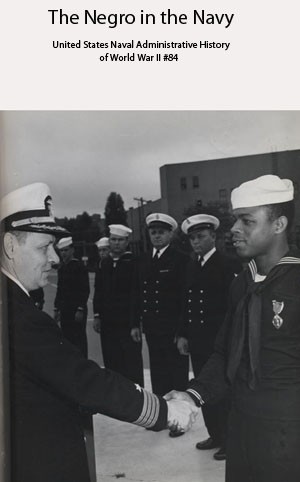
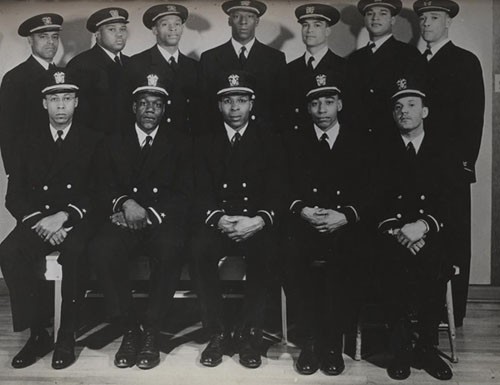
![Negro in the Navy Adminhist84 p42 "Under the direction of Chief Gunner's Mate Rex Ashley, USN, three gunner's mates assemble and study a 20-mm. gun, the type which they will man aboard the DE [destroyer escort]. Trainees at Norfolk are (left to right) Albert A. Davis, Gunner's Mate Second Class, and Warrren Vincent, Gunner's Mate Second Class. [Only two gunner's mates are identified in caption.]](/content/history/nhhc/research/library/online-reading-room/title-list-alphabetically/n/negro-navy-1947-adminhist84/_jcr_content/body/image_1.img.jpg/1421842895987.jpg)
![Negro in the Navy Adminhist84 p42a "The functions of the various parts of a 'blinker' are explained in detail by Signalman First Class Ernest V. Alderman, USNR, to Signalman Second Class Julius Holmes, who will be operating one aboard a DE [destroyer escort].](/content/history/nhhc/research/library/online-reading-room/title-list-alphabetically/n/negro-navy-1947-adminhist84/_jcr_content/body/image_2.img.jpg/1421843165711.jpg)
![Negro in the Navy Adminhist84 p42b "Following the remarks of Chief Quartermaster L.J. Russel, USNR, as he illustrates some of the navigational problems that may be raised when their DE [destroyer escort] is on a war mission. Charles W. Divers, Quartermaster Second Class; Royal H. Gooden, Quartermaster Second Class; Lewis F. Blanton, Jr., Quartermaster Third Class; and Clavin Dell, Quartermaster Second Class, prepare for their duties aboard the new destroyer escort.](/content/history/nhhc/research/library/online-reading-room/title-list-alphabetically/n/negro-navy-1947-adminhist84/_jcr_content/body/image_3.img.jpg/1421843370133.jpg)
![Negro in the Navy Adminhist84 p42c "Receiving and typing off messages, just as they'll be doing when the destroyer escort goes to sea, Radioman Second Class James W. Graham, (right), Radioman Second Class Wendell P. McMillan, and Radioman Third Class Alfred G. Mathis, get pointers at Norfolk NOB [Naval Operating Base] from instructor Radioman Second Class Charles G. Pelham, USN.](/content/history/nhhc/research/library/online-reading-room/title-list-alphabetically/n/negro-navy-1947-adminhist84/_jcr_content/body/image_4.img.jpg/1421843509285.jpg)
![Negro in the Navy Adminhist84 p42d "Electrician's Mates (left to right) Nathaniel O. Dyson, Second Class; Richard Hubbard, Third Class; and John W. Reagan, Second Class, listen as Chief Electrician's Mate John E. Taylor, USN, (Ret.), explains the workings of the power system and distribution process they'll be working with when serving aboard a DE [destroyer escort].](/content/history/nhhc/research/library/online-reading-room/title-list-alphabetically/n/negro-navy-1947-adminhist84/_jcr_content/body/image_5.img.jpg/1421844348082.jpg)
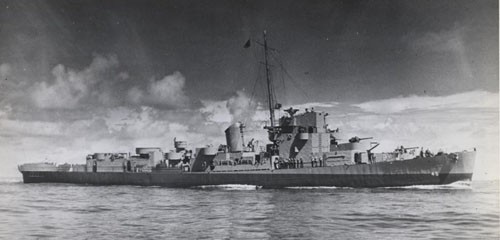
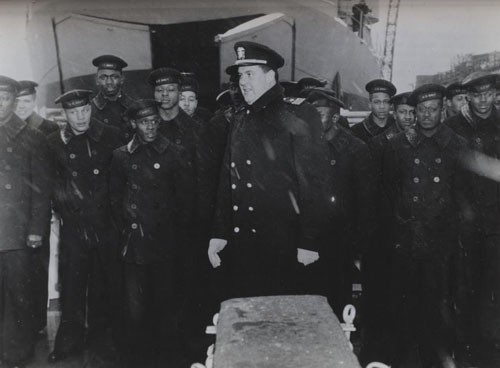
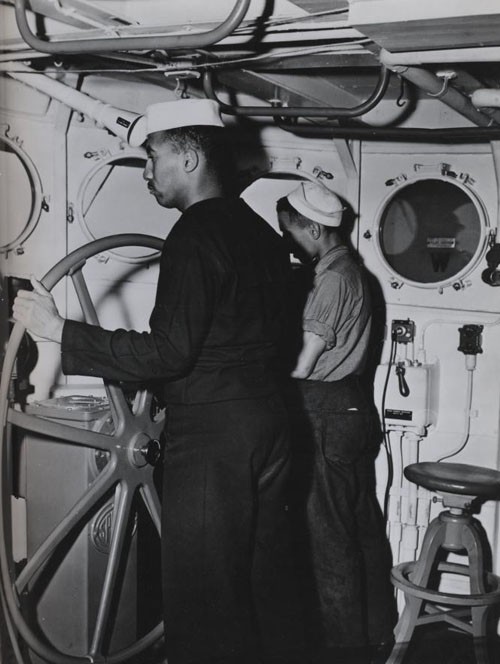
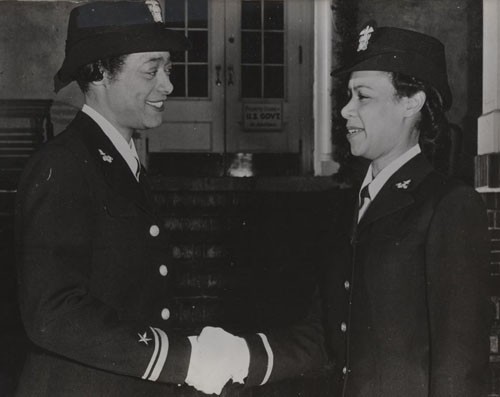
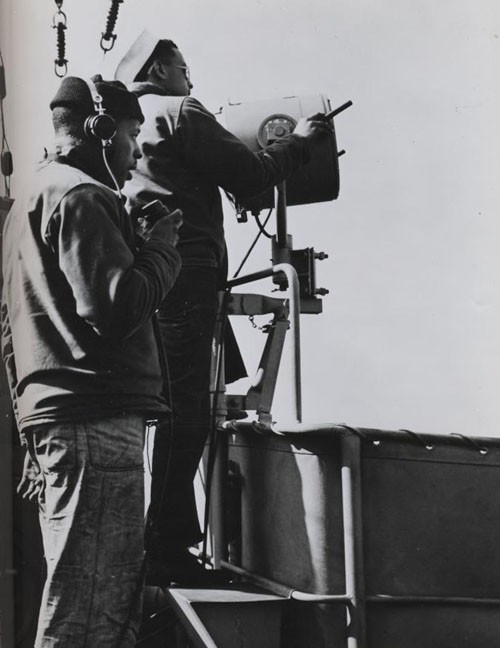
![Negro in the Navy Adminhist84 p42h "'What's a little snow?' laugh two members of the predominantly Negro crew of the USS Mason as they stand proudly beside the bow of their new destroyer escort vessel, commissioned at Boston Navy Yard today. Eventually, the entire crew of this ship will be Negroes. [Released: First Naval District, 20 March 1944.]](/content/history/nhhc/research/library/online-reading-room/title-list-alphabetically/n/negro-navy-1947-adminhist84/_jcr_content/body/image_11.img.jpg/1421845108956.jpg)
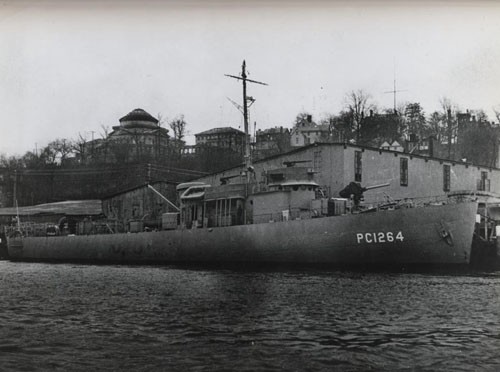
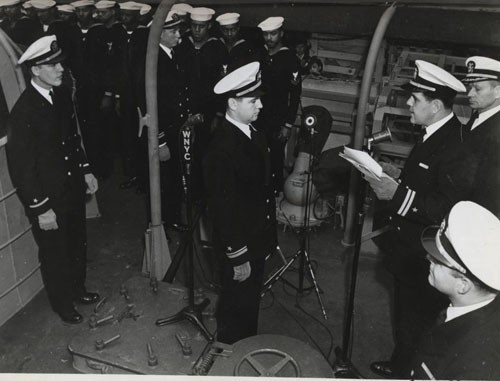
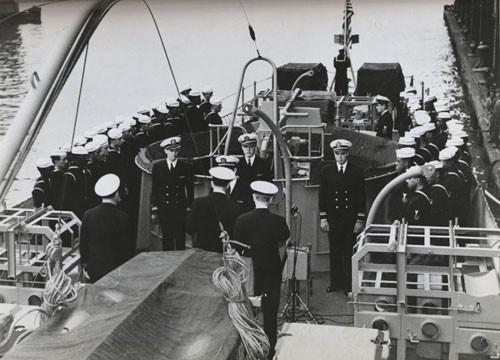
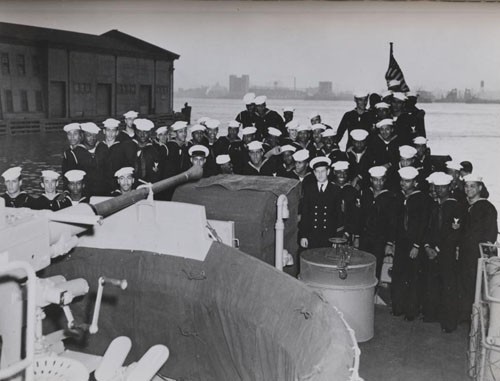
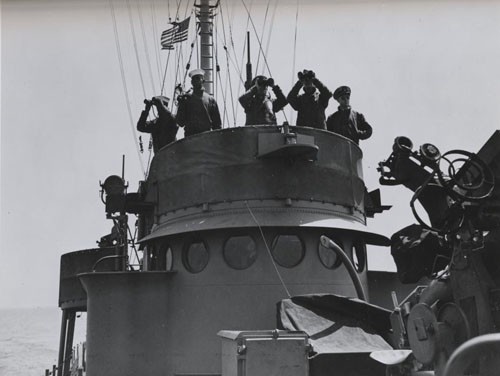
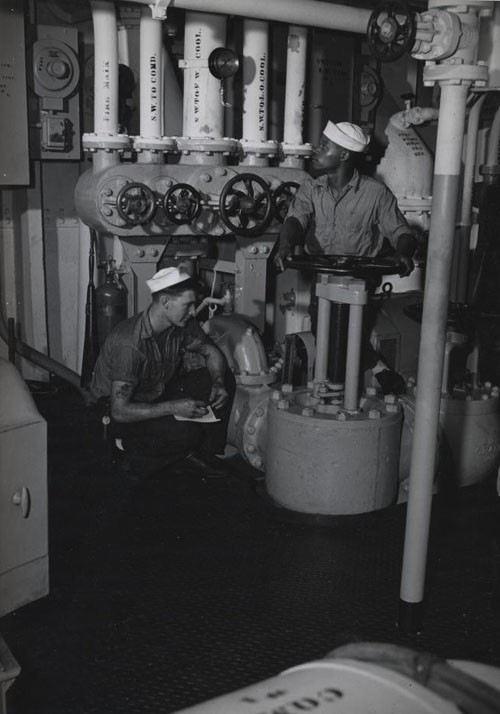
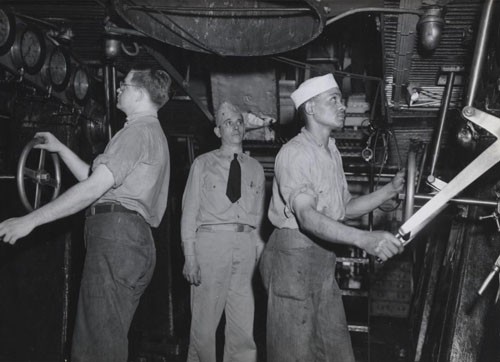
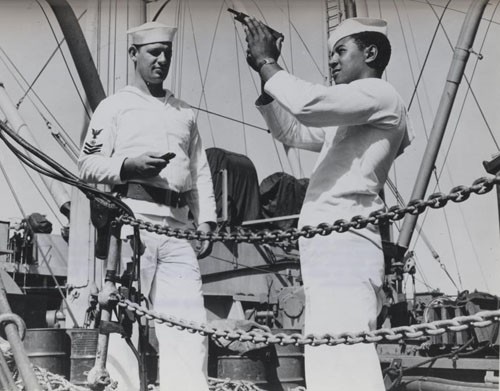
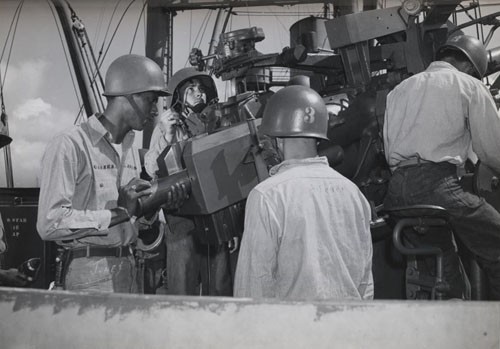
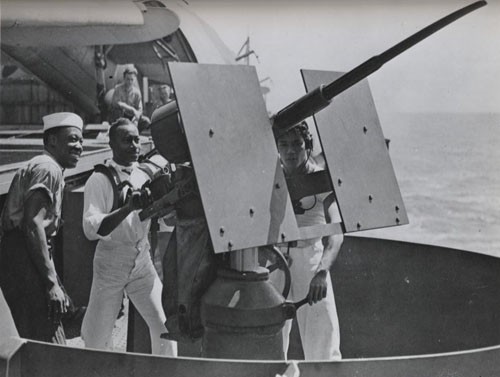
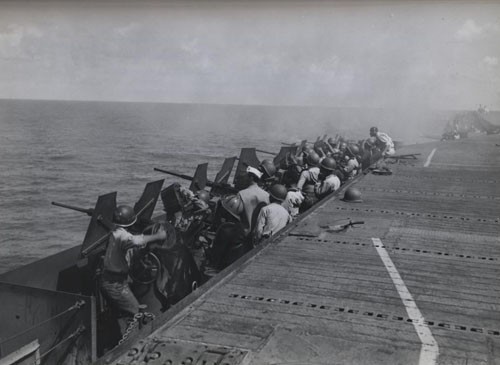
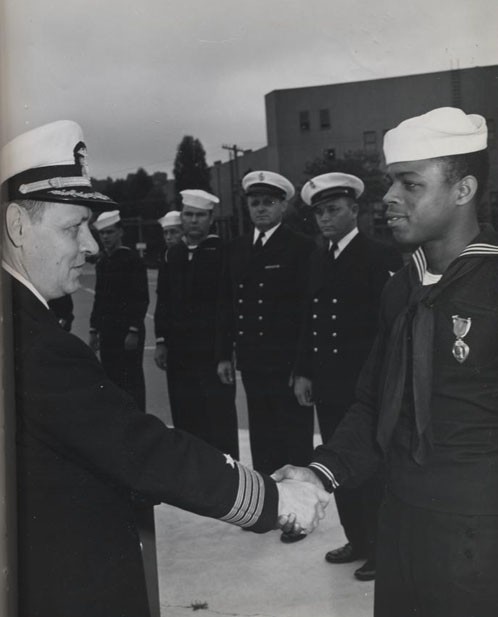
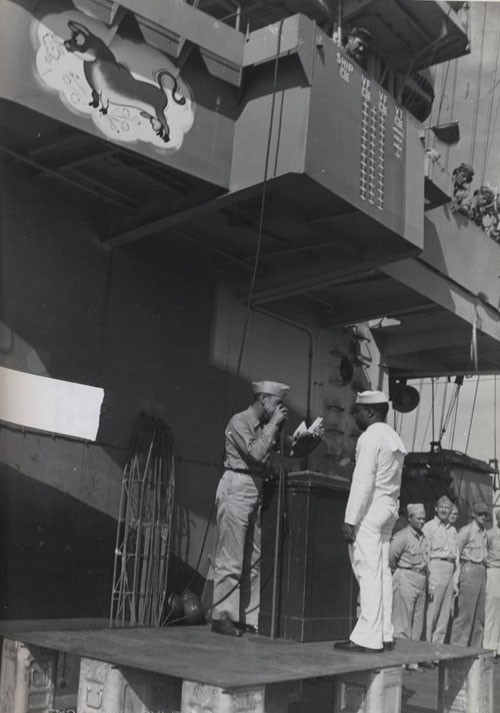
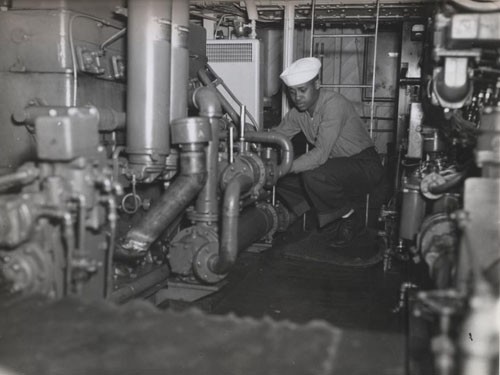
![Negro in the Navy Adminhist84 p45a "District craft duty in the United states. [Photograph is bound in book and top part of caption is not available. The first sailor's name is not available. Readable are: Edward L. Williams, Motor Machinist's Mate 2nd Class; Clifton W. Allen, Ship's Cook 2nd Class; Carl E. Harris, Seaman 1st Class; and Charles H. Brown, Boatswain's Mate 2nd Class.]](/content/history/nhhc/research/library/online-reading-room/title-list-alphabetically/n/negro-navy-1947-adminhist84/_jcr_content/body/image_26.img.jpg/1421853750388.jpg)
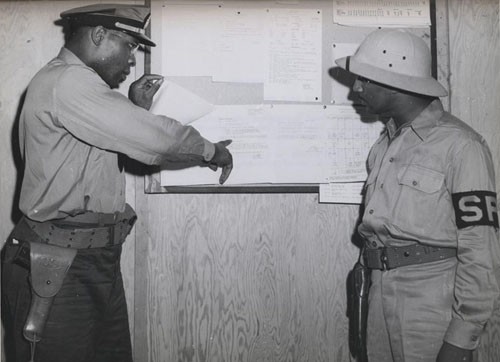
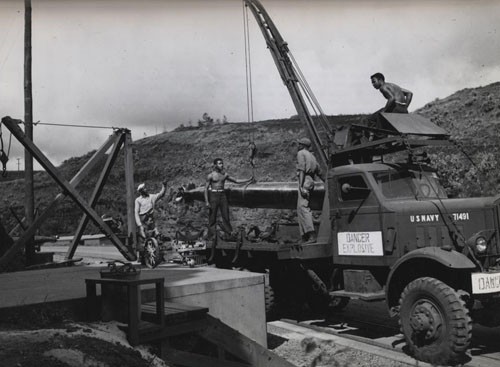
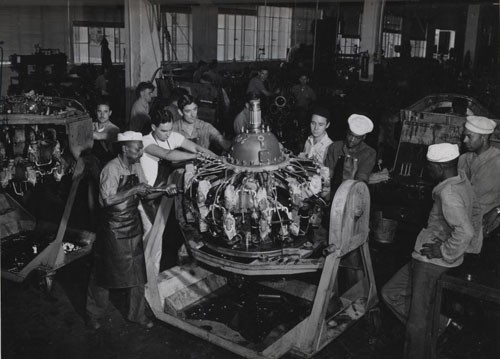
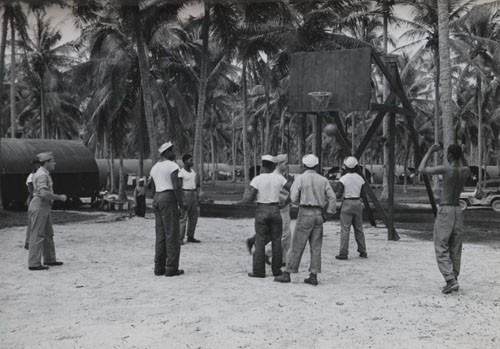
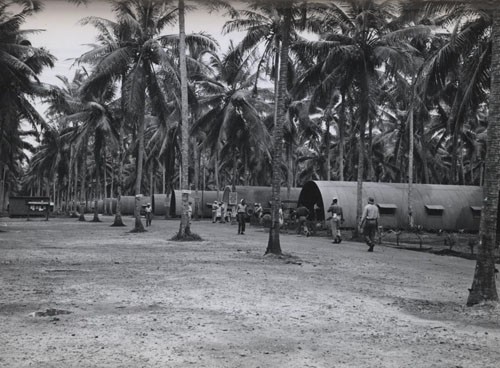
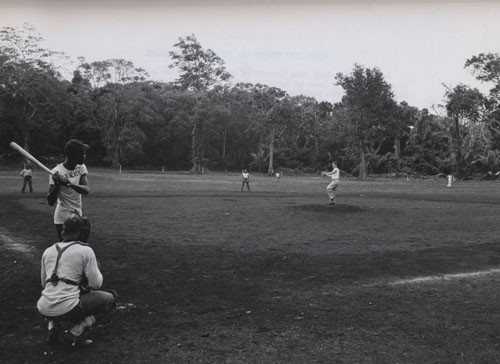
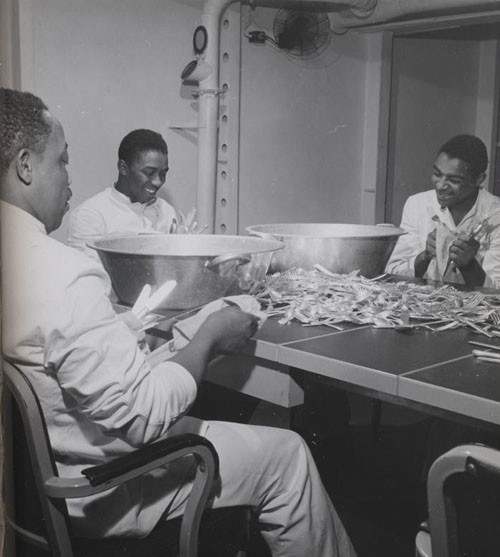
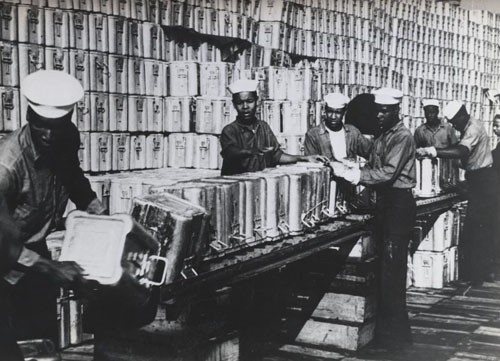
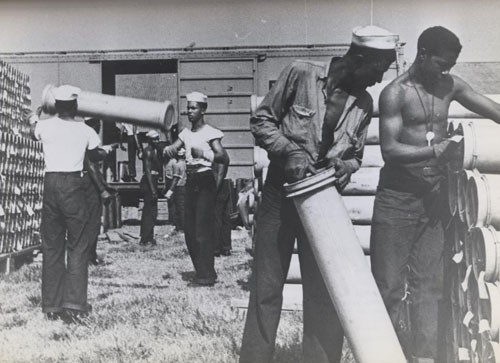
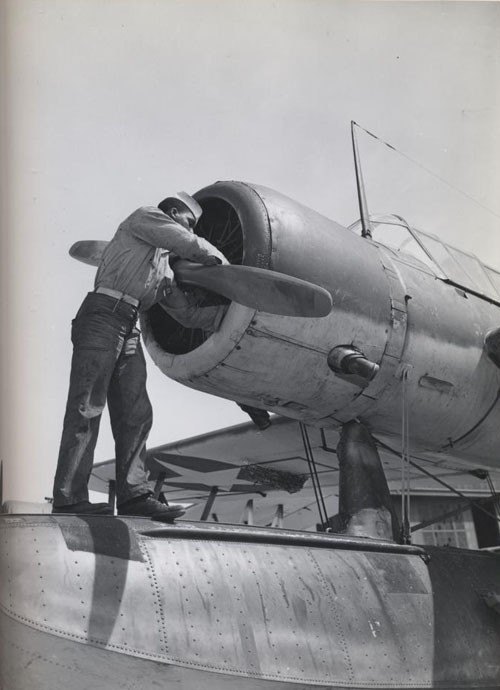
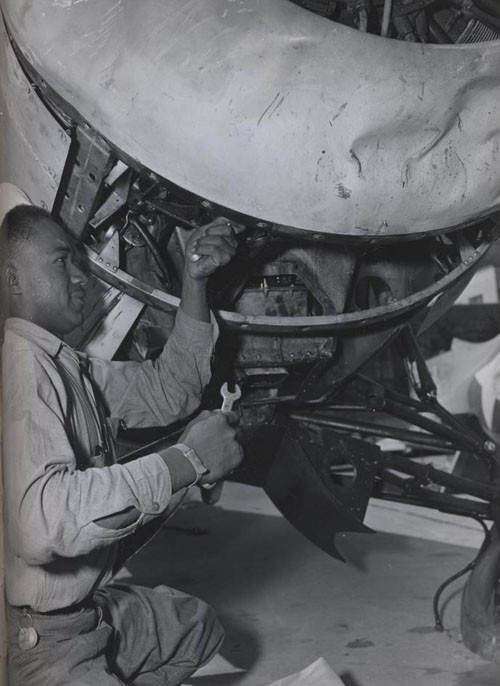
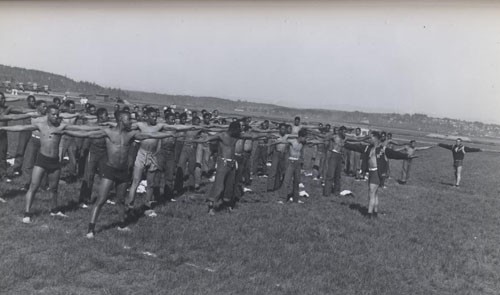
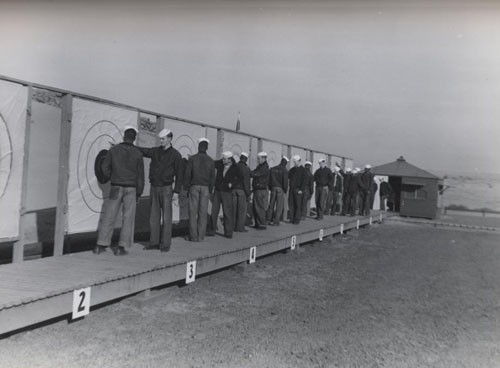
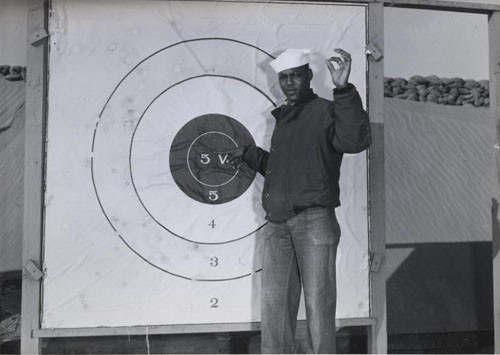
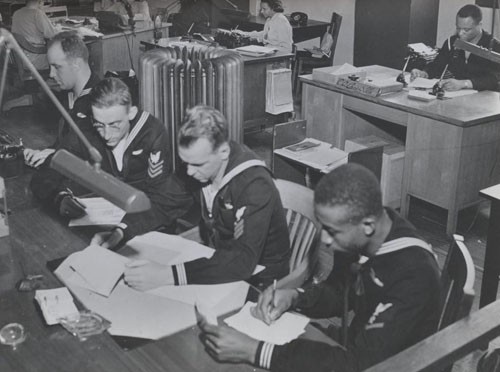
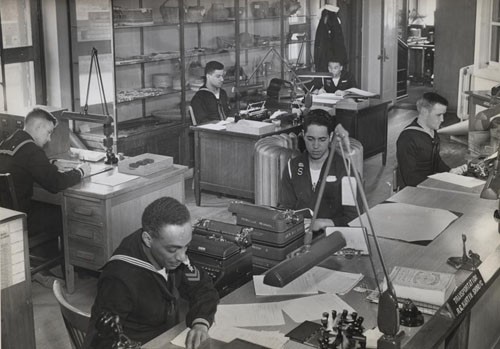
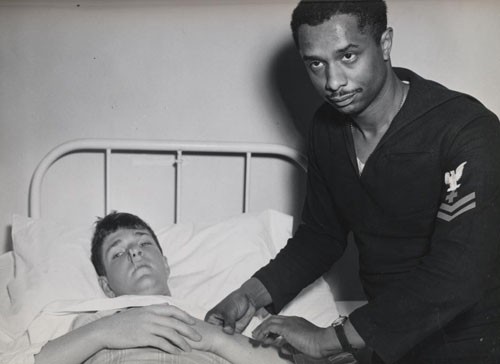
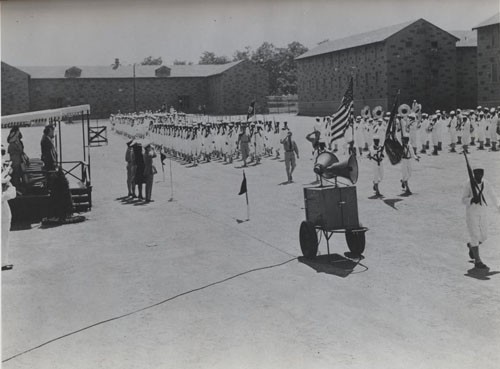
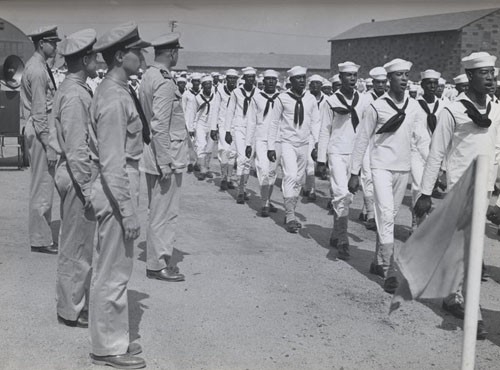
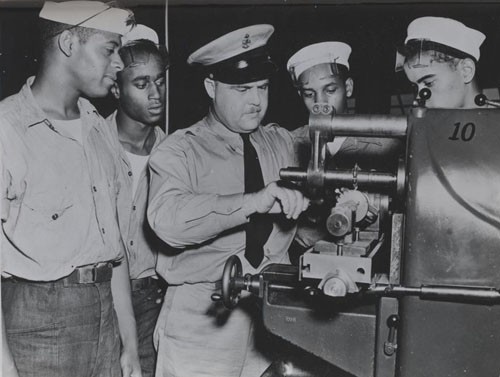
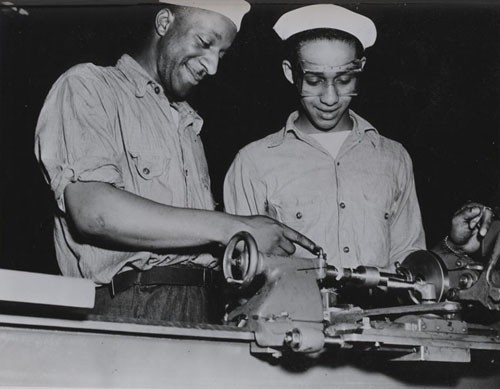
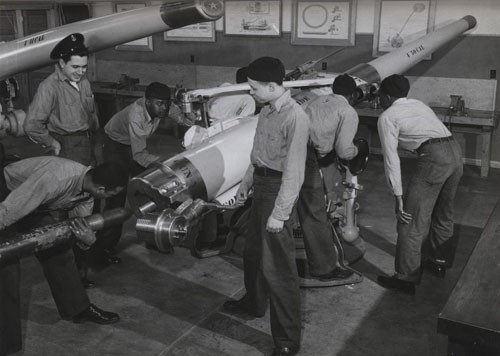
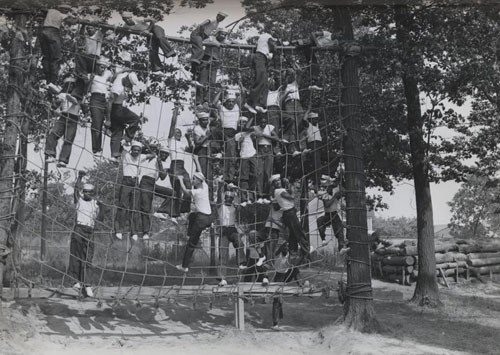
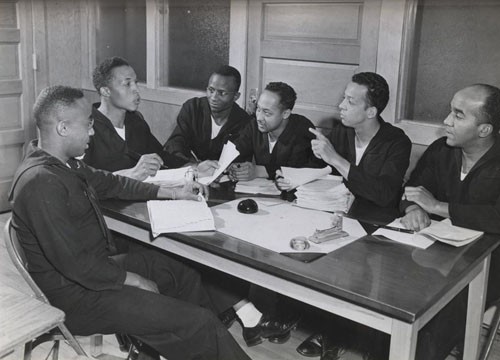
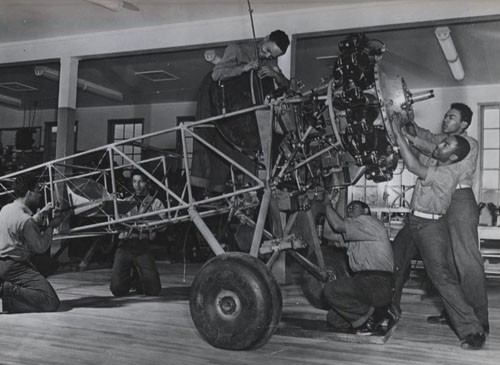
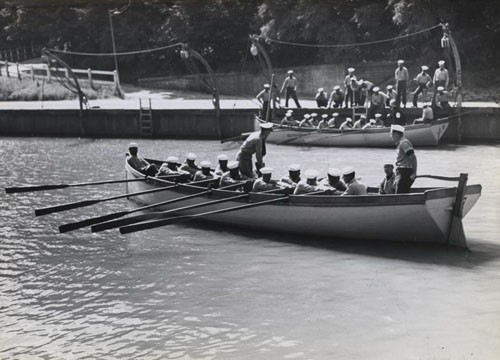
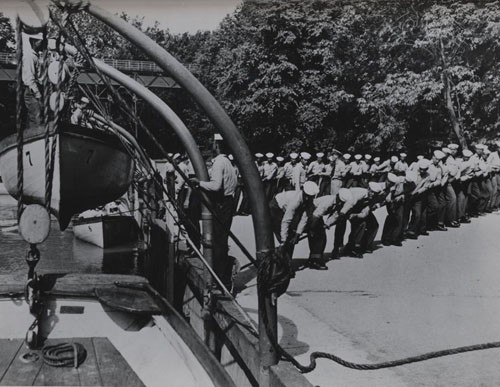
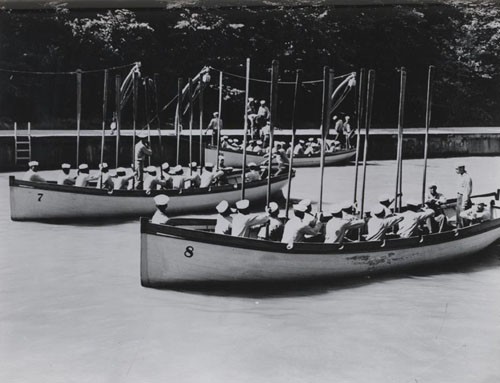
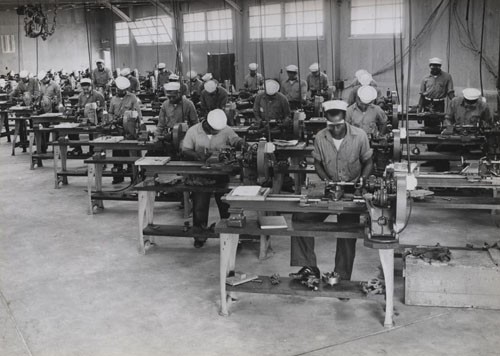
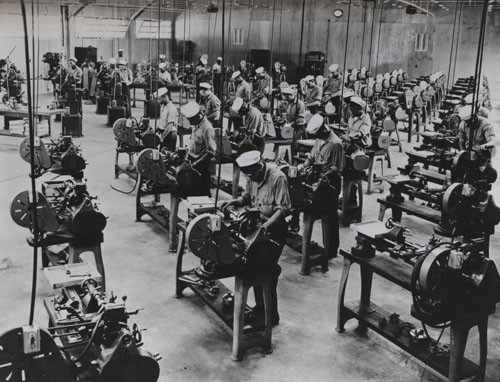
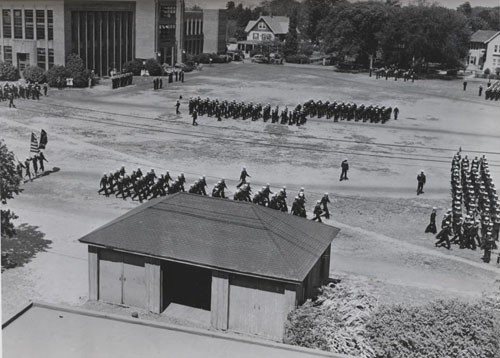
![Negro in the Navy Adminhist48 p58a "Marching to class, Hampton Institute, [Hampton, Virginia]."](/content/history/nhhc/research/library/online-reading-room/title-list-alphabetically/n/negro-navy-1947-adminhist84/_jcr_content/body/image_58.img.jpg/1421859742479.jpg)
